The
semantic structure of the word. Types of lexical meaning.
The branch
of Linguistics which studies the meaning of different linguistic
units is called Semantics.
The
part of Lexicology which studies the meaning and the development of
meaning of words is called Semasiology.
There
are different approaches to the problem of word meaning: 1) The
referential,
or denotational
approach
is characterized by the thought that (тем
что)
the essence (суть)
of meaning lies in the interconnection and interdependence between:
the word as the soundform, the referent, and the concept. Here
meaning
is the realization of the concept/notion by means of a definite
language system. 2)The functional,
or contextual
approach
is characterized by the idea that the meaning of a linguistic unit
may be studied only through its relation to other linguistic units.
Thus, meaning
is understood as the function of linguistic signs, or their use in
context.
Word
meaning is represented by different types of meaning: grammatical,
lexical, lexico-grammatical.
Grammatical
meaning
is the component of word meaning, recurrent in identical sets of
individual forms of different words. It is expressed by:
-
word-form (such as books,
girls, boys – the meaning of plurarity; looked, asked – tense
meaning); -
the position of the word in
relation to other words (e.g. He sings well, She dances badly –
‘sings’ and ‘dances’ are found in identical positions
between a pronoun and an adverb, their identical distribution proves
that they have identical gr.m.)
Lexico-grammatical
meaning
of the word is the common denominator (знаменатель)
to all the meanings of the words belonging to a certain
lexico-grammatical class or group of words.
Lexical
meaning
is the component of word meaning recurrent in all the forms of the
word. The word forms go, goes, went, gone, going have different
gr.m., but they have one and the same l.m. ‘the process of
movement’.
The main
component of L.m.
are:
-
the
denotational
meaning
of words is the same for all the speakers. It is the realization of
the concept by means of the given language. -
The
pragmatic
aspect
of l.m. is the part of meaning, that conveys information on the
situation of communication: information on the ‘time and space’
relationship of the participants, information on the participants in
the given language community, information on the register of
communication. -
The
connotational
meaning
conveys the speaker’s attitude toward what he is speaking about.
There are 4 main types of connotations: a) The emotional
connotation
expresses human emotions and feelings (e.g. daddy, father); b) The
evaluative
connotation expresses approval or disapproval (e.g. agent and spy,
planning and scheming=planning secretly); c) The intensifying
connotation adds emphasis (усиление)
to the meaning. (e.g. enormous, huge, tremendous=very); d) The
stylistic
connotation determines the functional speech style characteristic of
the word usage (dad-father-parent; colloquial-neutral-bookish).
Polysemy is the
abbility of a word to have more than one m-g. The causes of the
development of polysemy in Eng. are:1) the great amount of
monosyllabic root words; 2) an abundance of words of long duration,
which in the course of time were used to express more new m-gs thus
becoming highly polysemantic. Monosemantic words, i.e. words which
have only one m-g form. They are mostly names of birds
(blackbird,swallow), animals (walrus, weasel), fishes (ruff, perch) &
special terms (systole, phoneme). The bulk of Eng. words are
polysemantic,i.e. they have several m-gs. The m-g in speech is
contextual. In a definite context any polysemantic word expresses
only one m-g. A word in one of its m-g in which it is used in speech
is called a lexico-semantic variant of a word. The semantic structure
of a polysemantic word presents a set of interrelated &
interdependent lexico-semantic variants. WE distinguish on the
synchronic level: — the basic (major) & the minor; — the central
& the marginal; -direct & transferred(figurative); -. Every
LSV is connected with the major m-g due to the existence of the
common semantic components/ semes. The seme is the smallest further
indivisible unit of m-g, the smallest unit of the plan of content.
The analysis of the m-g into these components, or semes, is called
the componential analysis.
Соседние файлы в папке Гос филология
- #
- #
- #
- #
- #
- #
- #
- #
- #
- #
- #
- Размер: 241.5 Кб
- Количество слайдов: 21

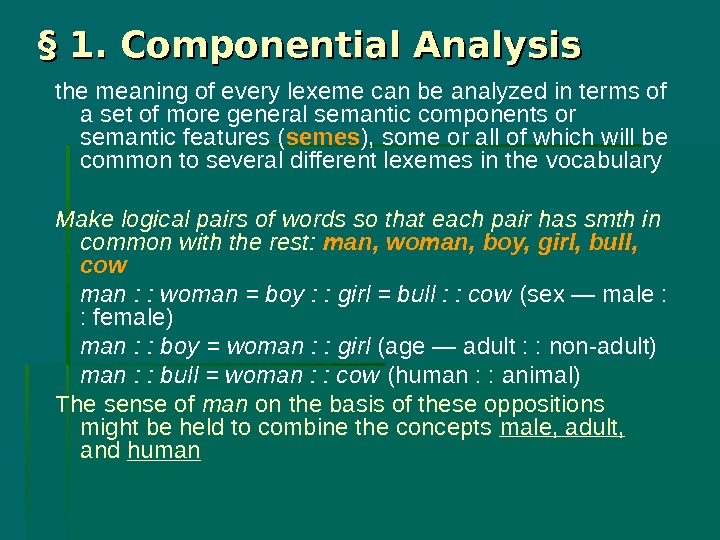


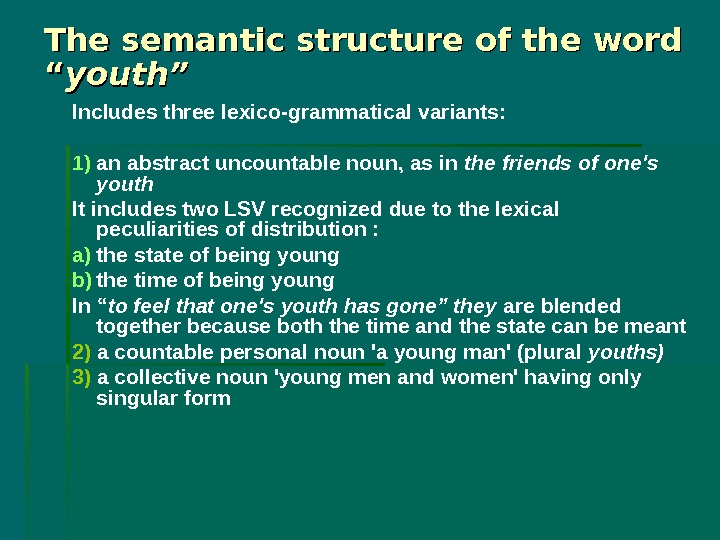



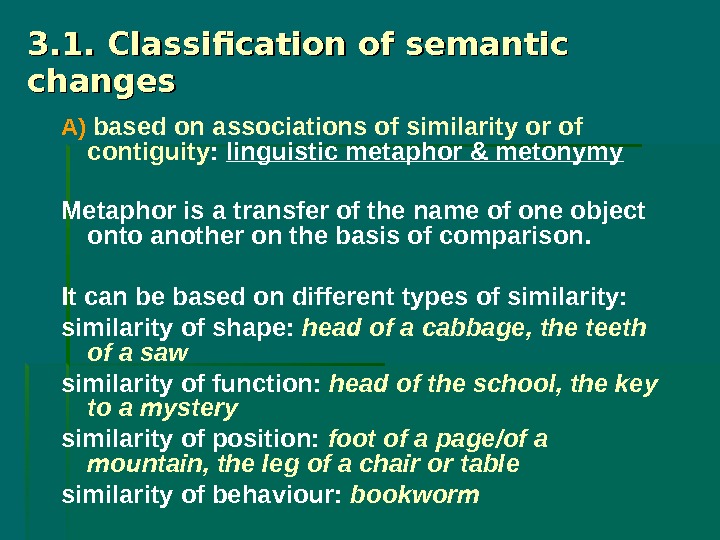

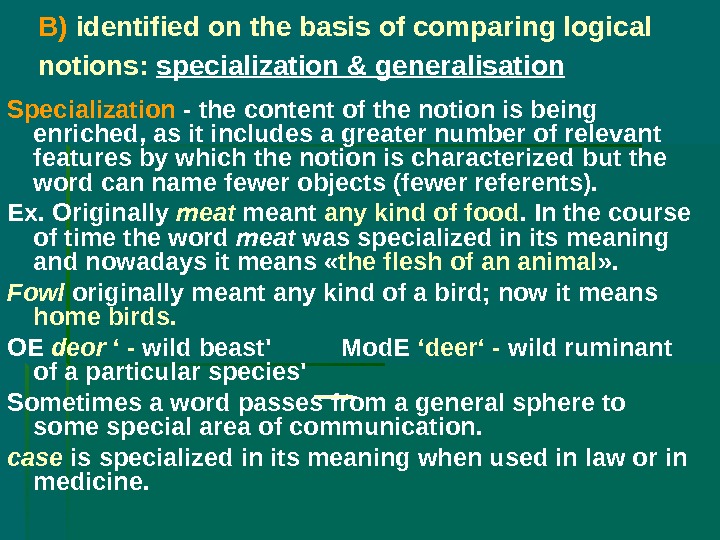




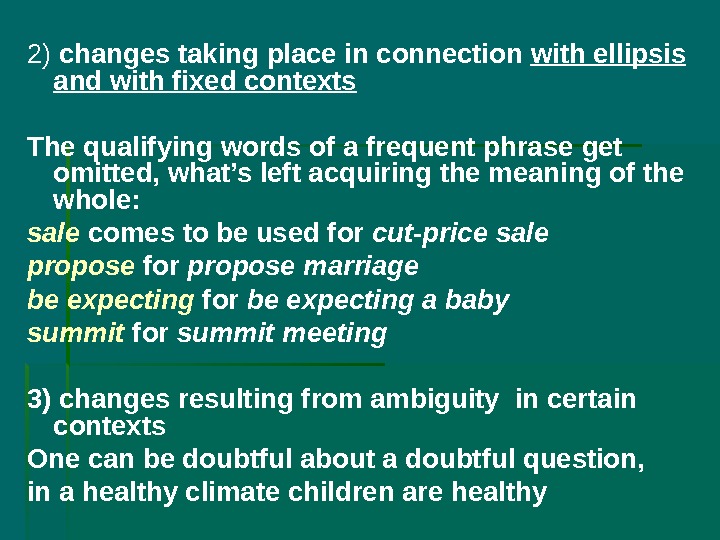


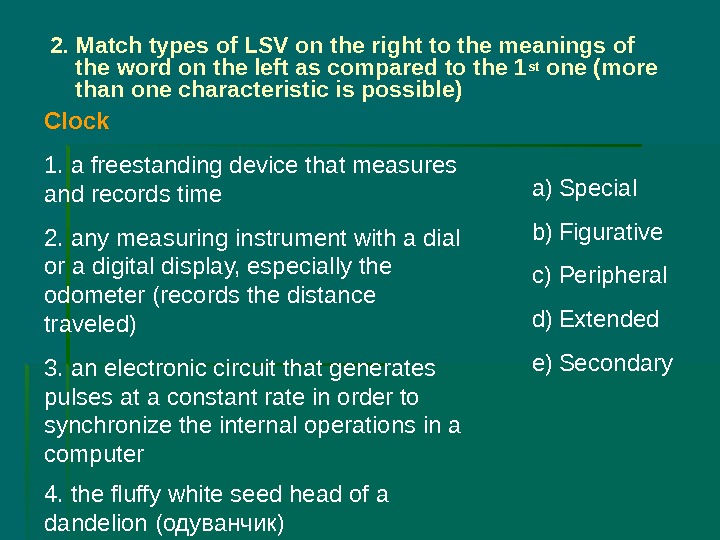


Слайд 1Lecture 3
Semantic Structure of the Word and Its Changes
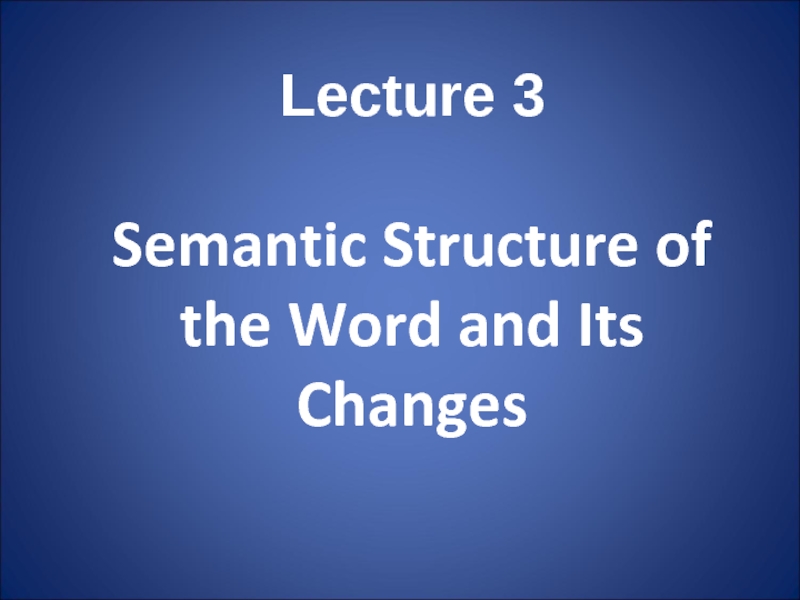
Слайд 2Plan:
Semantics / semasiology. Different approaches to word-meaning.
Types of word-meaning.
Polysemy. Semantic
structure of words. Meaning and context.
Change of word-meaning: the causes, nature and results.
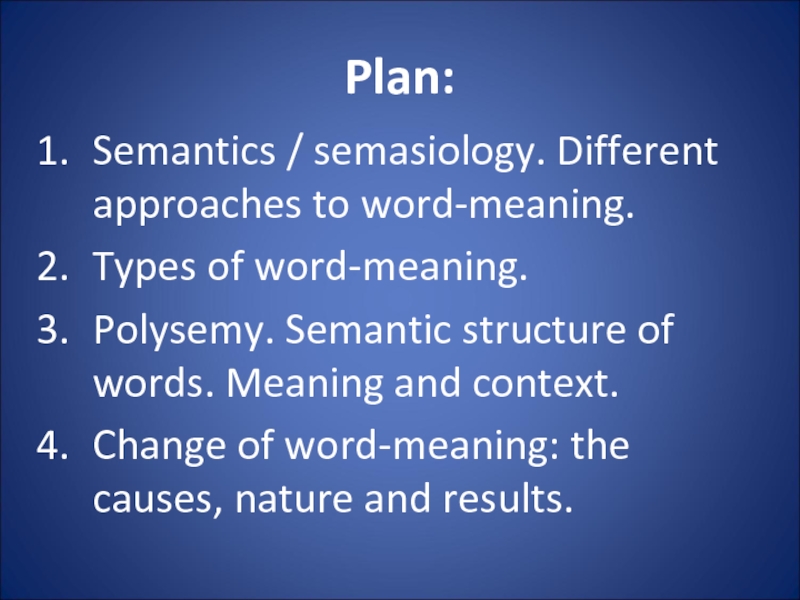
Слайд 3List of Terms:
semantics
referent
referential meaning
grammatical meaning
lexical meaning
denotational meaning
connotational meaning
polysemantic word
polysemy
lexical-semantic variants
basic meaning
peripheral
meaning
primary meaning
secondary meaning
radiation
concatenation
lexical context
grammatical context
thematic context
ellipsis
differentiation of synonyms
linguistic analogy
metaphor
metonymy
restriction of meaning
extension of meaning
ameliorative development of meaning
pejorative development of meaning
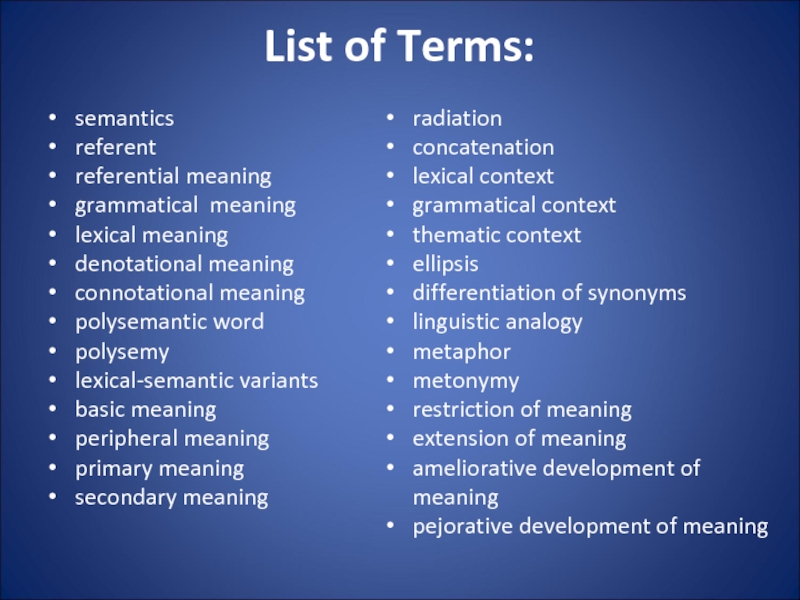
Слайд 4
It is meaning that makes language useful.
George A. Miller,
The science of word, 1991
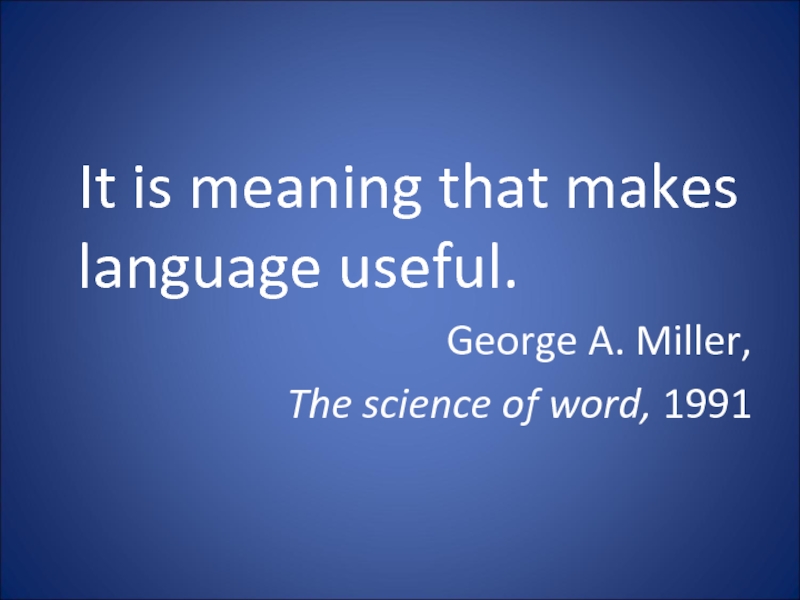
Слайд 5
1. Semantics / semasiology. Different approaches to word-meaning
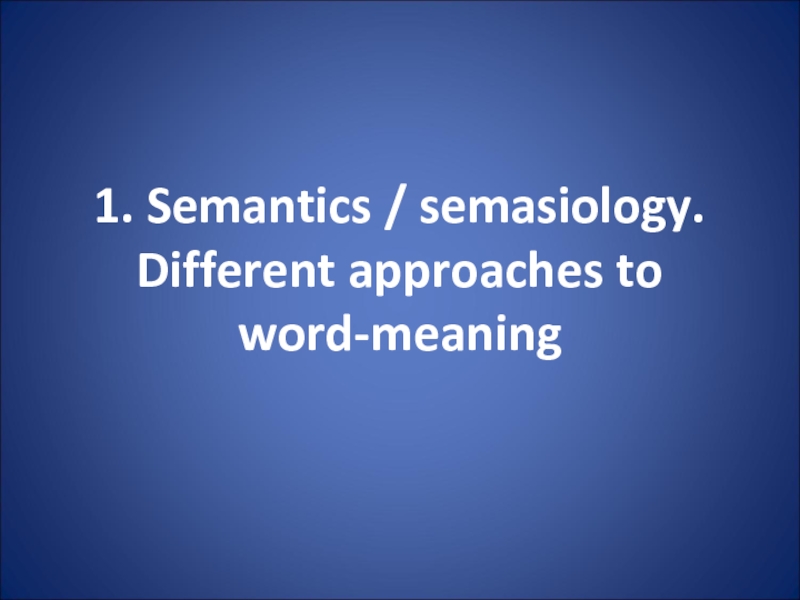
Слайд 6
The function of the word as a unit of
communication is possible by its possessing a meaning.
Among the word’s various characteristics meaning is the most important.
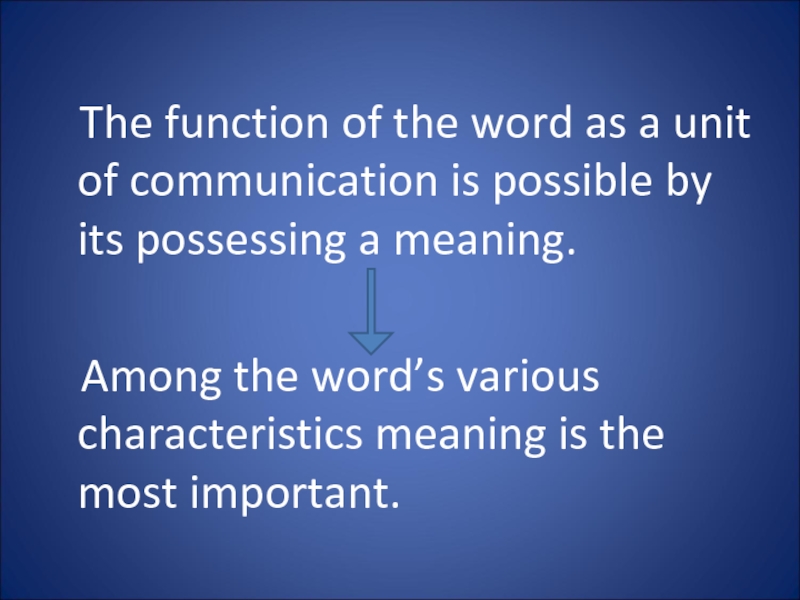
Слайд 7
«The Meaning of Meaning» (1923) by C.K. Ogden and I.A. Richards
– about 20 definitions of meaning
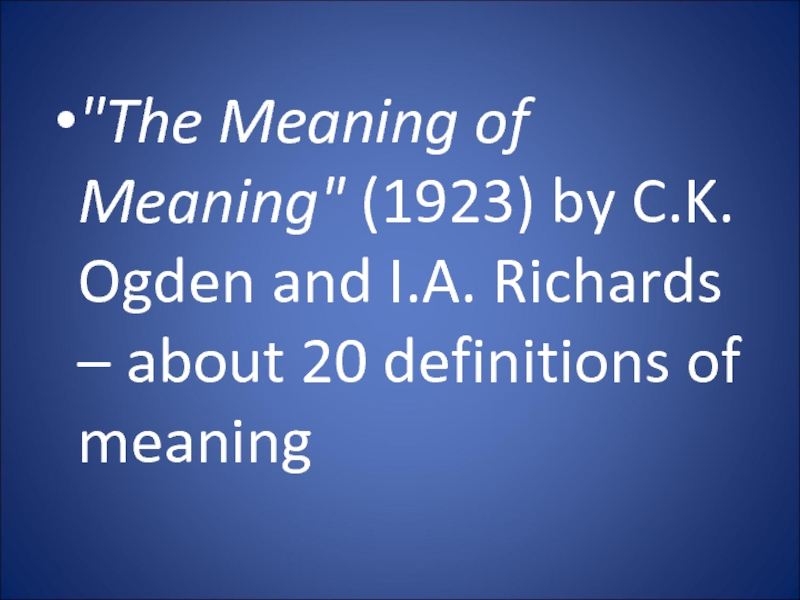
Слайд 8Meaning of a linguistic unit, or linguistic meaning, is studied by
semantics
(from Greek – semanticos ‘significant’)
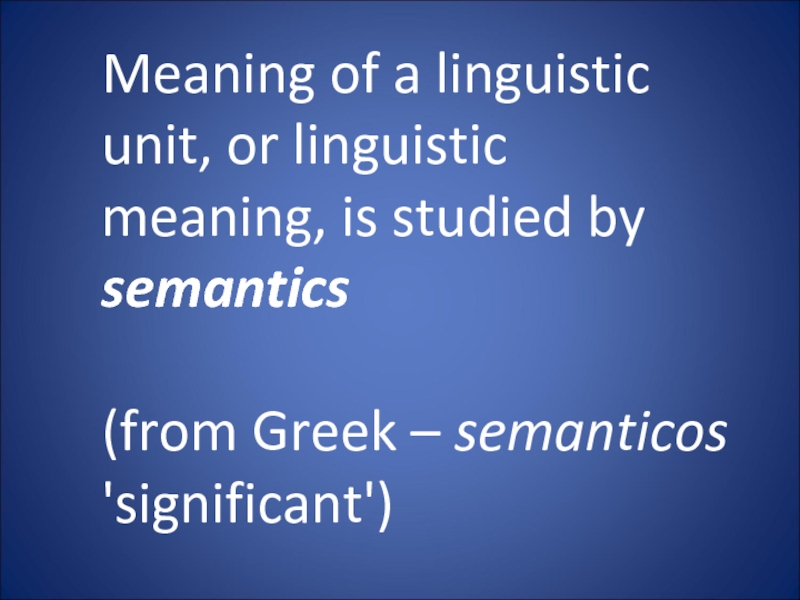
Слайд 9
This linguistic study was pointed out in 1897 by
M. Breal

Слайд 10
Semasiology is a synonym for ‘semantics’
(from
Gk. semasia ‘meaning’ + logos ‘learning’)
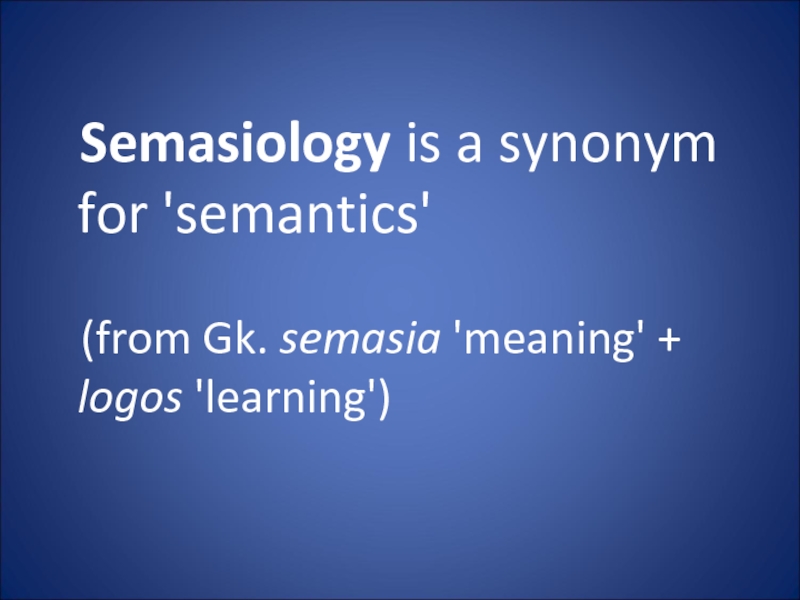
Слайд 11Different Approaches to Word Meaning:
ideational (or conceptual)
referential
functional
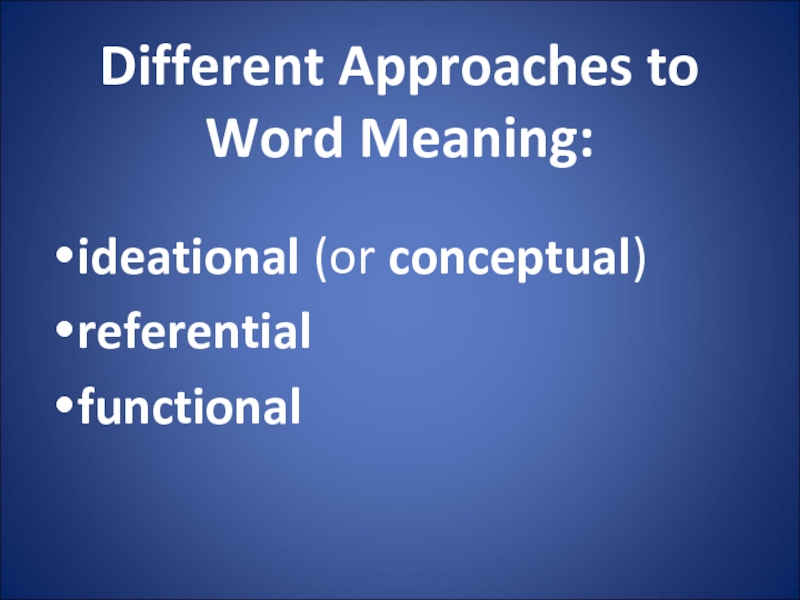
Слайд 12
The ideational theory can be considered the earliest theory
of meaning.
It states that meaning originates in the mind in the form of ideas, and words are just symbols of them.

Слайд 13A difficulty:
not clear why communication and understanding are possible if
linguistic expressions stand for individual personal ideas.

Слайд 14Meaning:
a concept with specific structure.
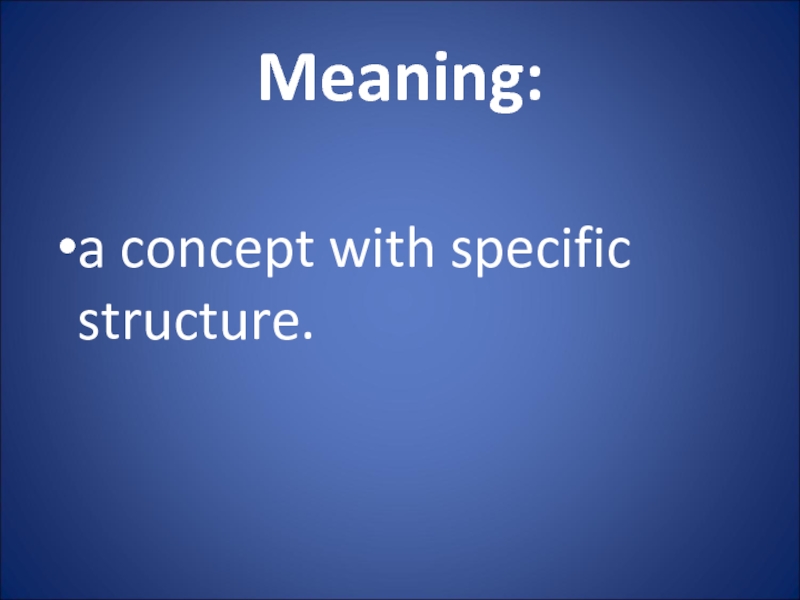
Слайд 15
Do people speaking different languages have different conceptual systems?
If people
speaking different languages have the same conceptual systems why are identical concepts expressed by correlative words having different lexical meanings?
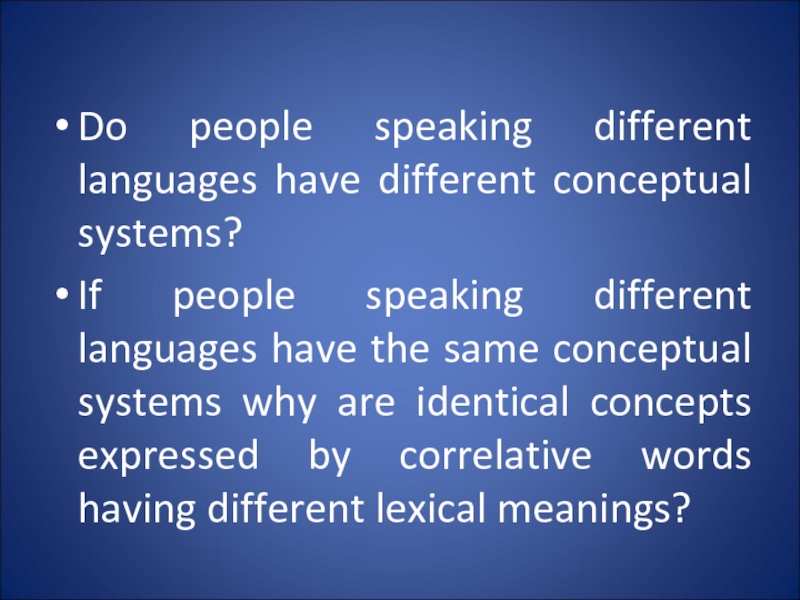
Слайд 16
finger ‘one of 10 movable parts of joints at the end
of each human hand, or one of 8 such parts as opposed to the thumbs‘
and
палец ‘подвижная конечная часть кисти руки, стопы ноги или лапы животного’
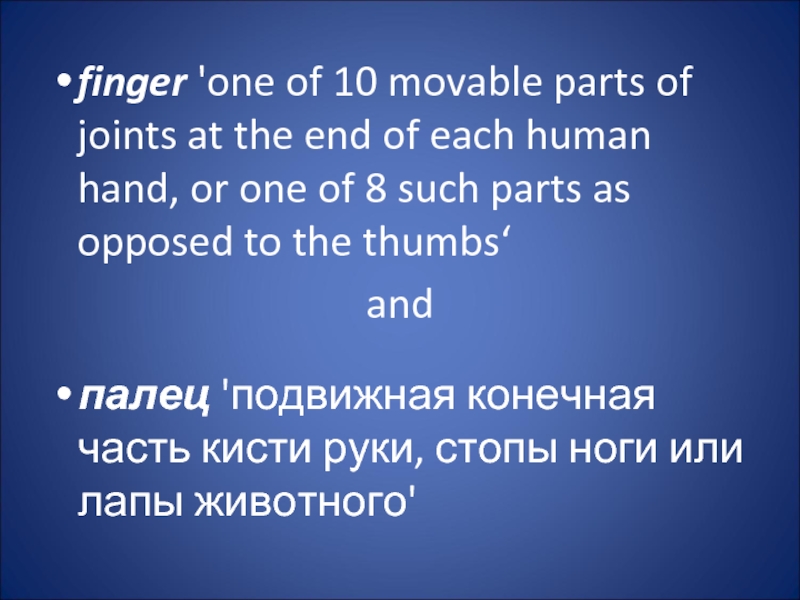
Слайд 17
Referential theory is based on interdependence of things,
their concepts and names.
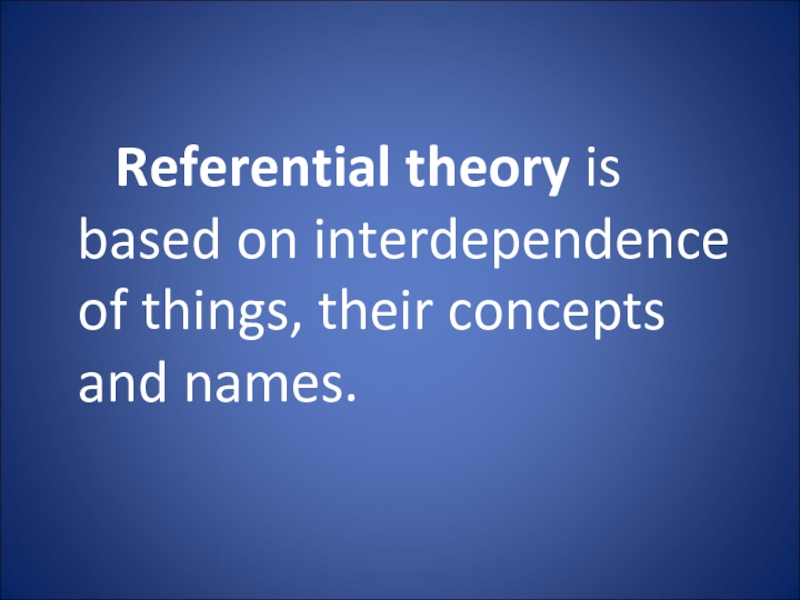
Слайд 18
The complex relationships between referent (object denoted by the
word), concept and word are traditionally represented by the following triangle:
Thought = concept
Symbol = word Referent = object
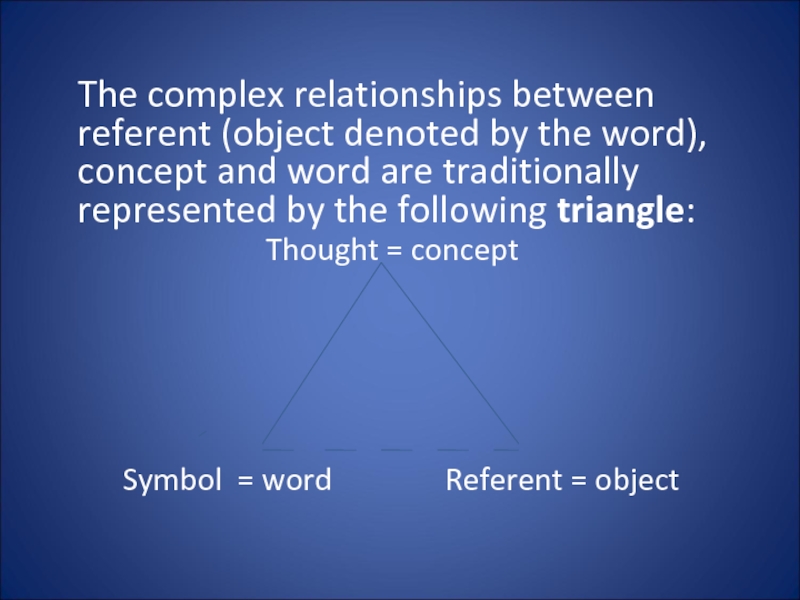
Слайд 19
an animal, with 4
legs and a tail, can bark and
bite
dog
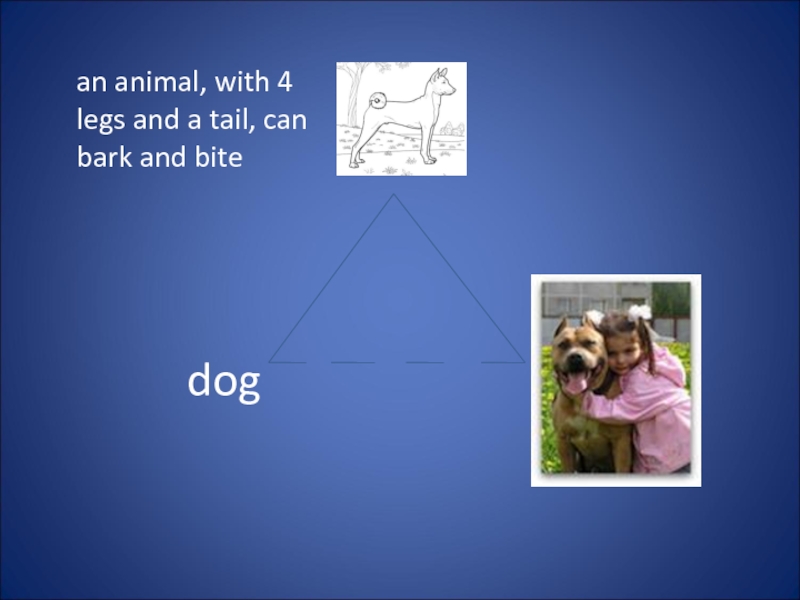
Слайд 20Meaning concept
different words having different meanings may be
used to express the same concept
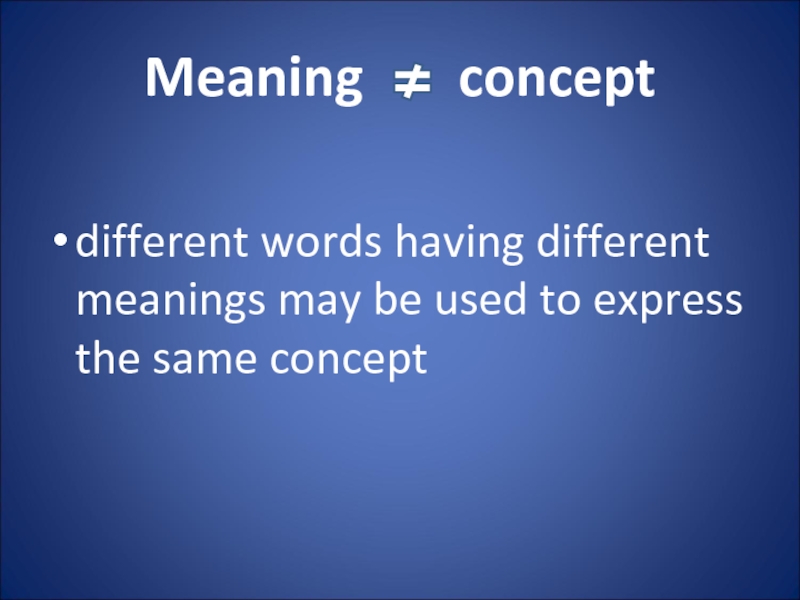
Слайд 21Concept of dying
die
pass away
kick the bucket
join the majority,
etc

Слайд 22Meaning symbol
In different languages:
a word with the same
meaning have different sound forms (dog, собака)
words with the same sound forms have different meaning (лук, look)
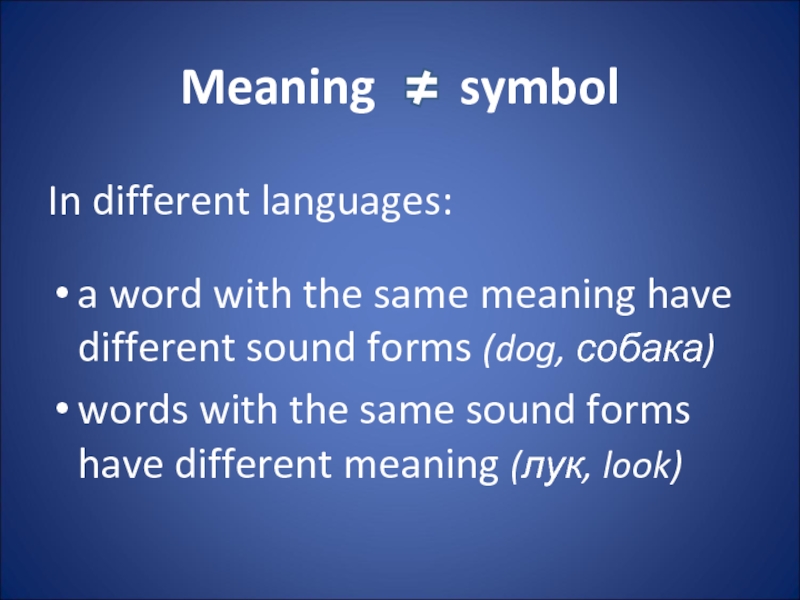
Слайд 23Meaning referent
to denote one and the same object
we can give it different names
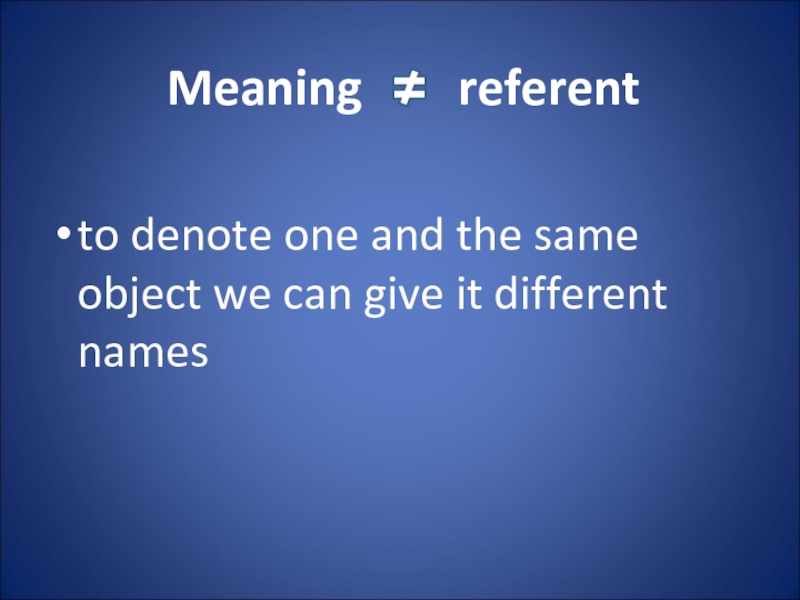
Слайд 24A horse
in various contexts:
horse,
animal,
creature,
it, etc.
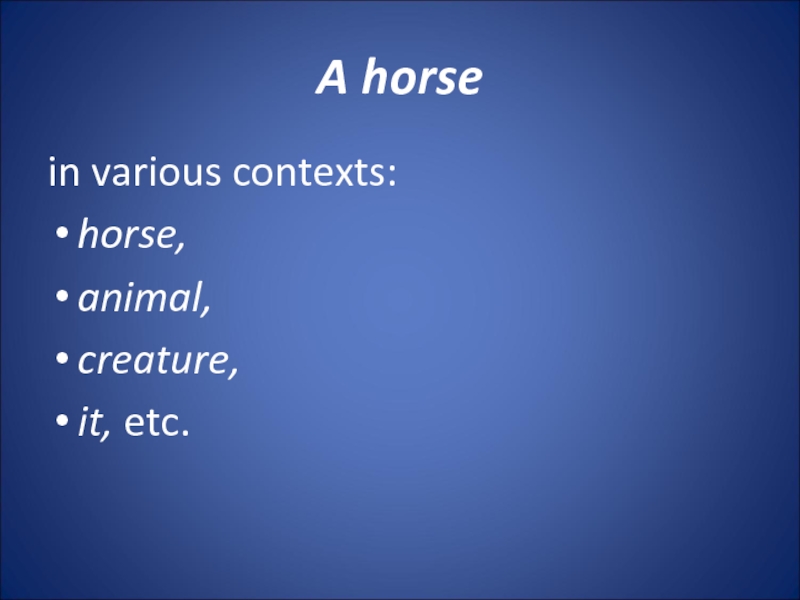
Слайд 25Word meaning:
the interrelation of all three components of
the semantic triangle: symbol, concept and referent, though meaning is not equivalent to any of them.
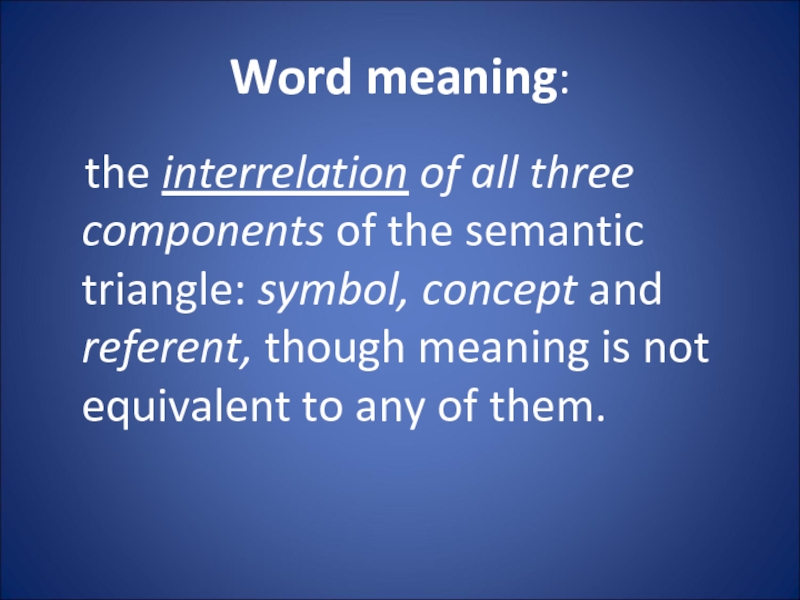
Слайд 26
Functionalists study word meaning by analysis of the way
the word is used in certain contexts.
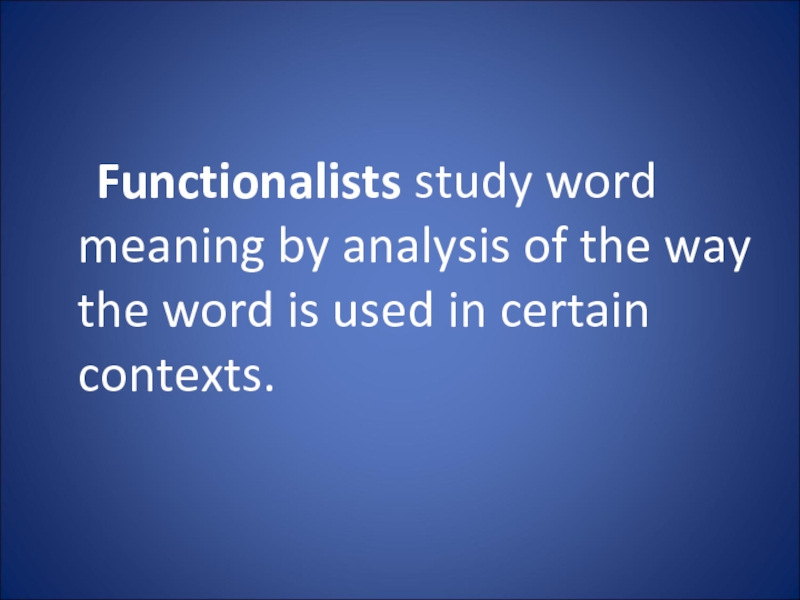
Слайд 27
The meaning of a word is its use
in language.
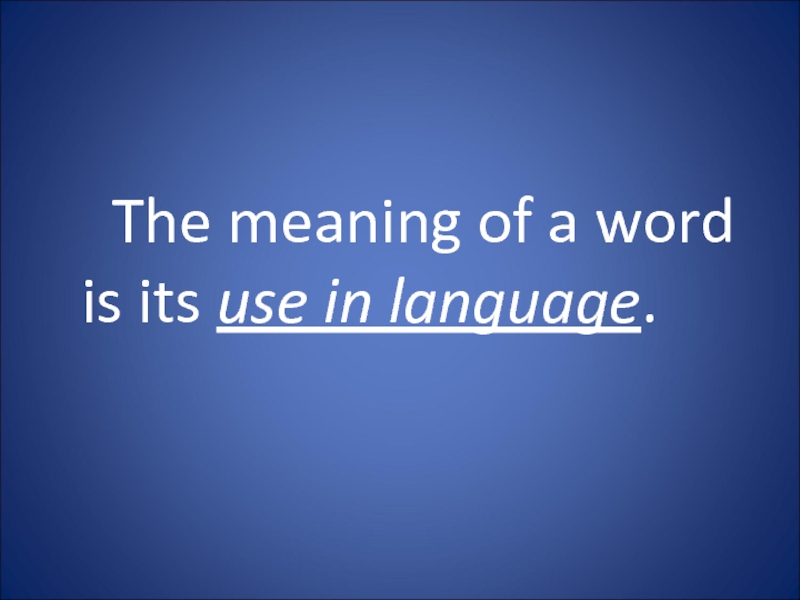
Слайд 28cloud and cloudy
have different meanings because in speech they function
differently and occupy different positions in relation to other words.
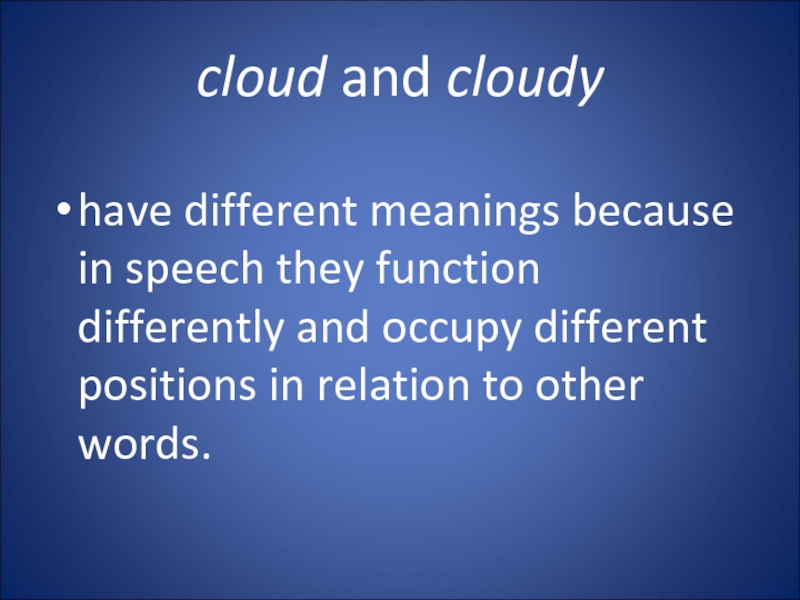
Слайд 29Meaning:
a component of the word through which a concept
is communicated
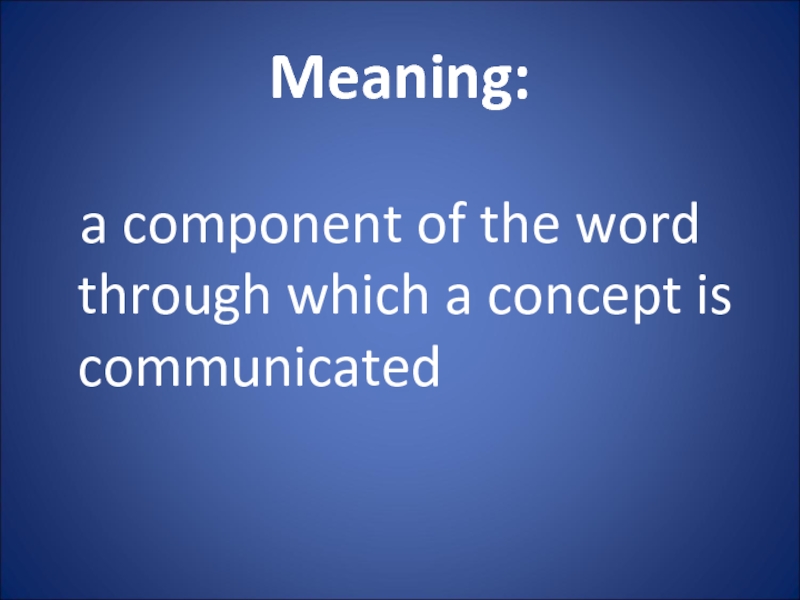
Слайд 31According to the conception of word meaning as a specific structure:
functional
meaning: part of speech meaning (nouns usually denote «thingness», adjectives – qualities and states)
grammatical: found in identical sets of individual forms of different words (she goes/works/reads, etc.)
lexical: the component of meaning proper to the word as a linguistic unit highly individual and recurs in all the forms of a word (the meaning of the verb to work ‘to engage in physical or mental activity’ that is expressed in all its forms: works, work, worked, working, will work)
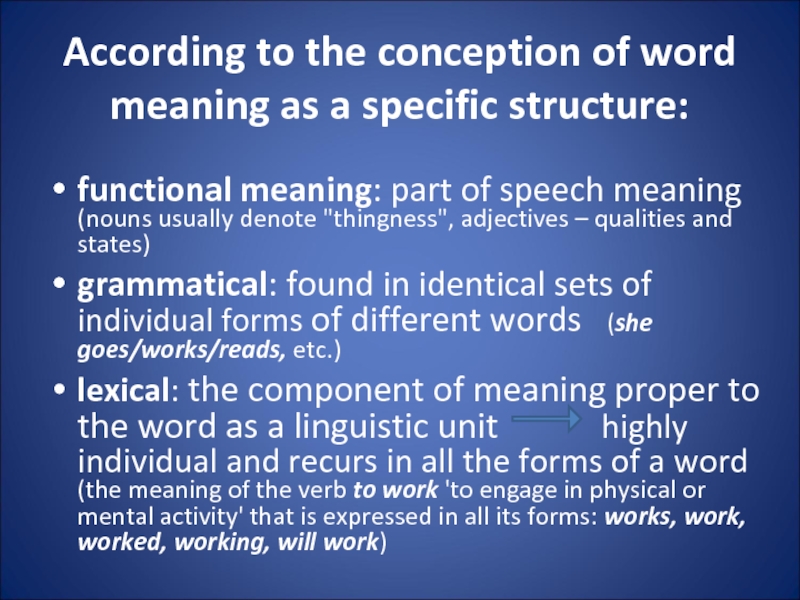
Слайд 32Lexical Meaning:
denotational
connotational
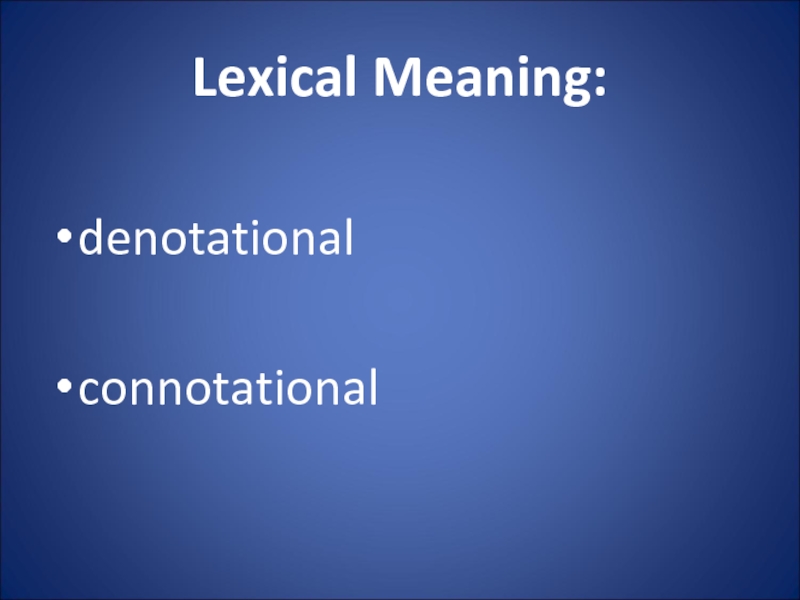
Слайд 33
Denotational lexical meaning provides correct reference of a word to an
individual object or a concept.
It makes communication possible and is explicitly revealed in the dictionary definition (chair ‘a seat for one person typically having four legs and a back’).

Слайд 35
Connotational lexical meaning is an emotional colouring of the
word. Unlike denotational meaning, connotations are optional.
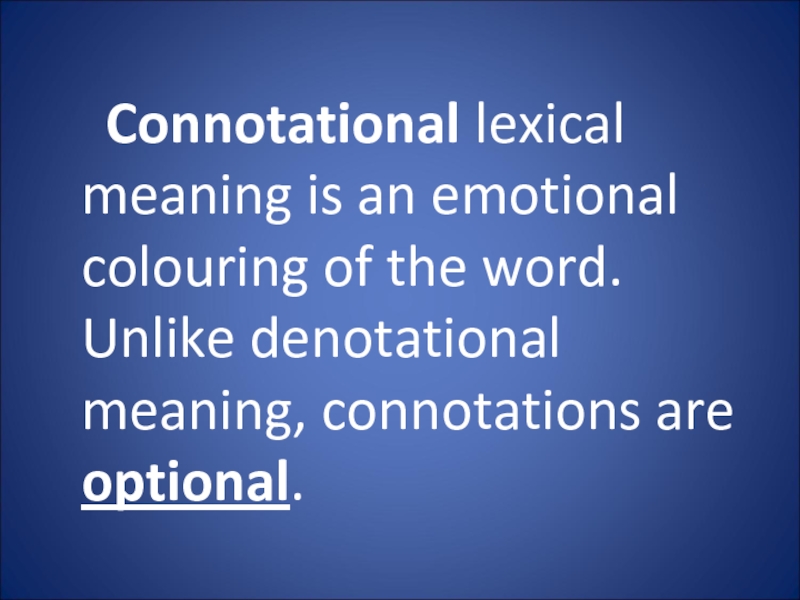
Слайд 36Connotations:
Emotive charge may be inherent in word meaning (like in attractive,
repulsive) or may be created by prefixes and suffixes (like in piggy, useful, useless).
It’s always objective because it doesn’t depend on a person’s perception.
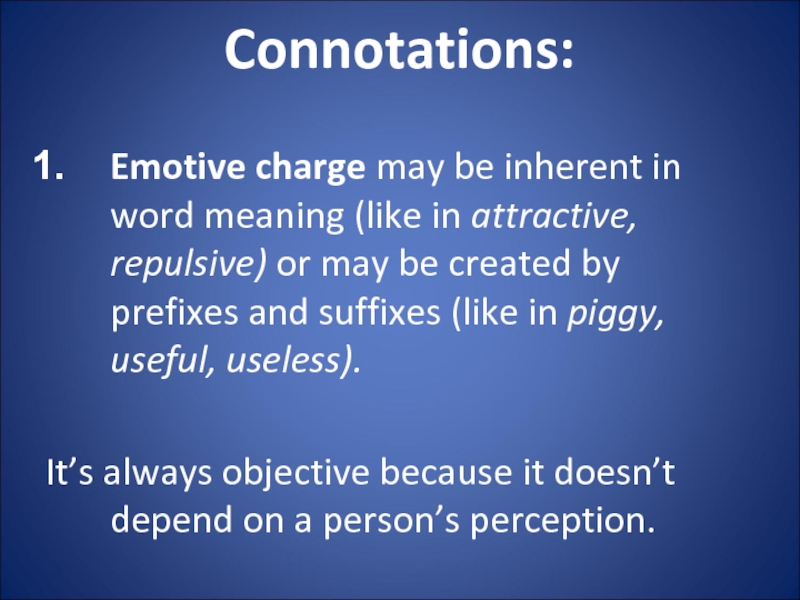
Слайд 37
2. Stylistic reference refers the word to a certain style:
neutral words
colloquial
bookish,
or literary words
Eg. father – dad – parent .
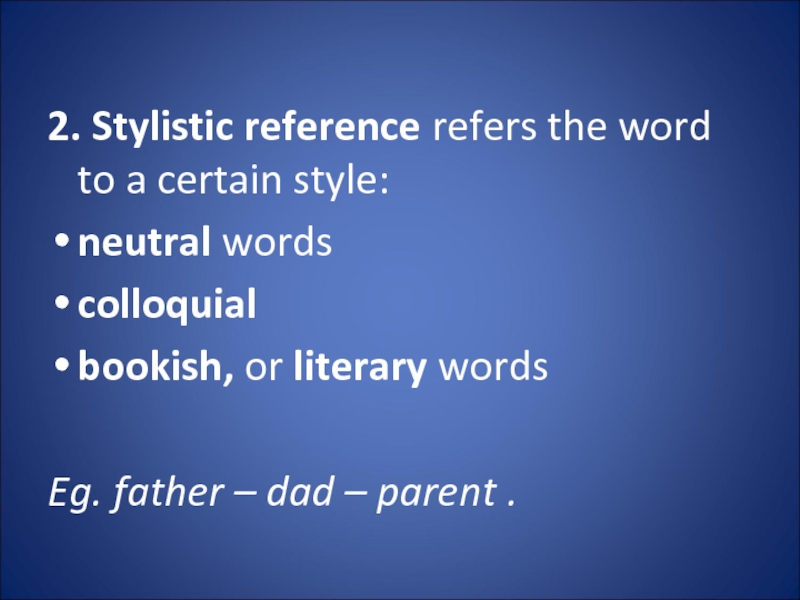
Слайд 38
3. Evaluative connotations express approval or disapproval (charming, disgusting).
4. Intensifying connotations
are expressive and emphatic (magnificent, gorgeous)

Слайд 39
Denotative component
Lonely = alone, without company
To glare = to look
Connotative component
+ melancholy, sad (emotive con.)
+ 1) steadily, lastingly (con. of duration)
+ 2) in anger, rage (emotive con.)
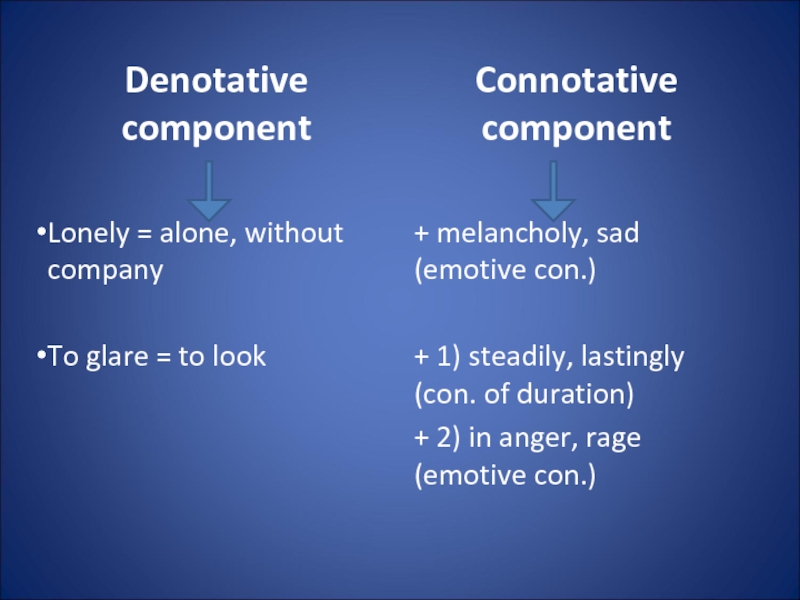
Слайд 40
3. Polysemy. Semantic structure of words. Meaning and context
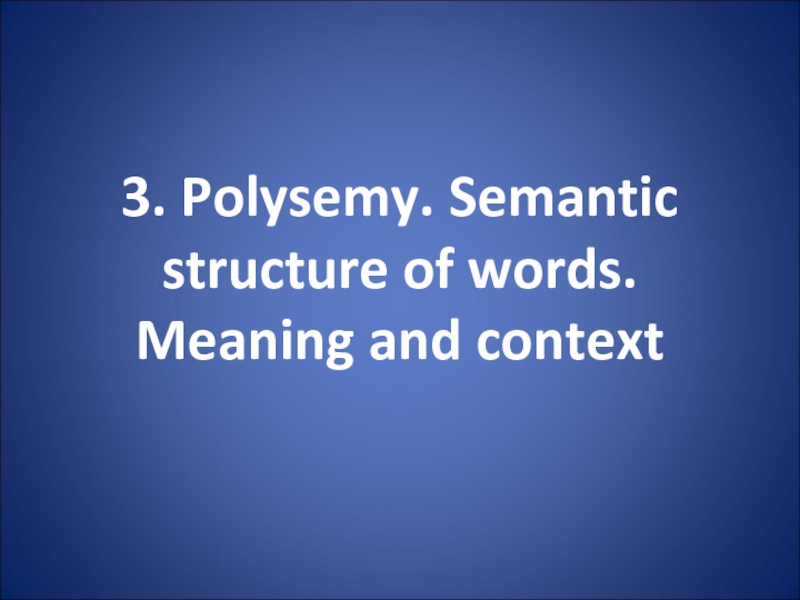
Слайд 41
A polysemantic word is a word having more than one meaning.
Polysemy
is the ability of words to have more than one meaning.
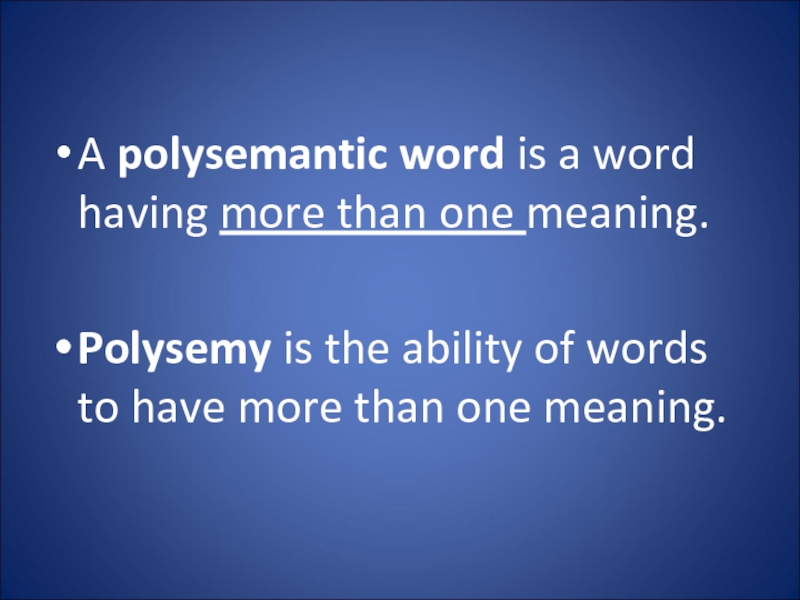
Слайд 42
Most English words are polysemantic.
A well-developed polysemy is a great advantage in a language.
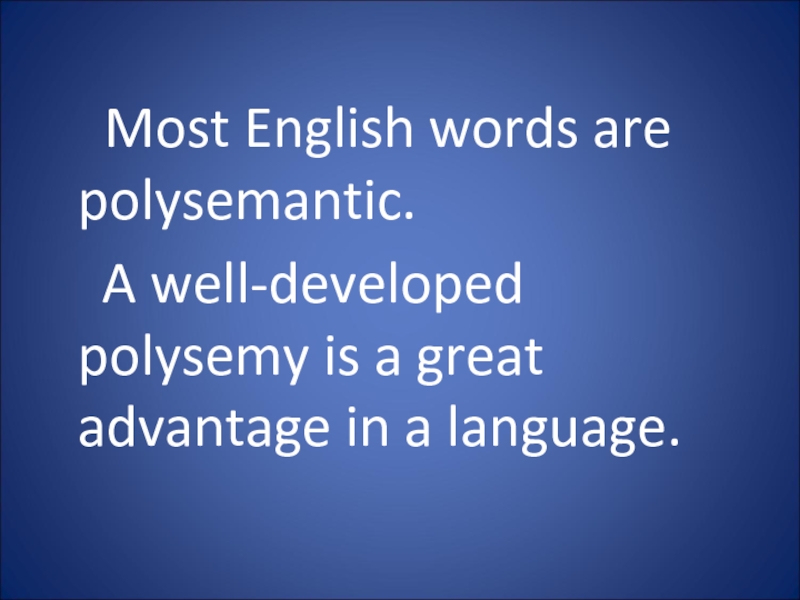
Слайд 43Monosemantic Words:
terms (synonym, bronchitis, molecule),
pronouns (this, my, both),
numerals, etc.
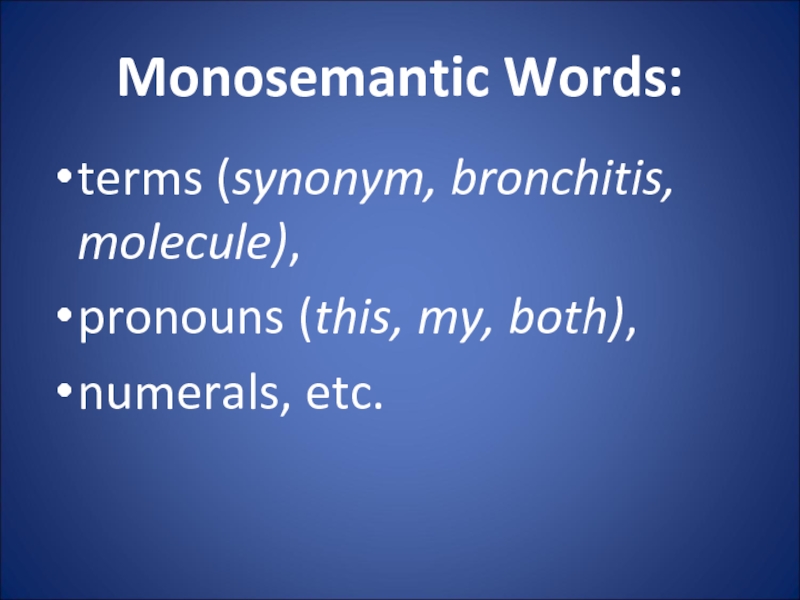
Слайд 44The main causes of polysemy:
a large number of:
1) monosyllabic words;
2) words of long duration (that existed for centuries).
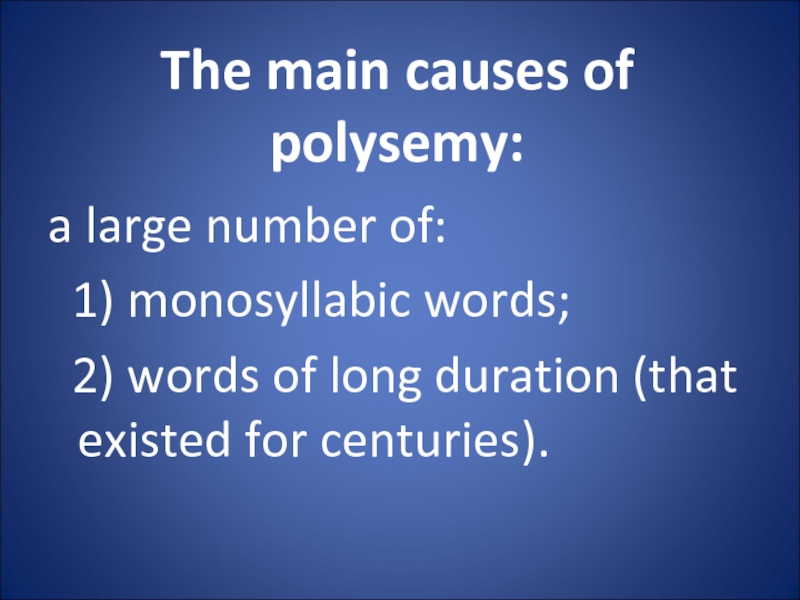
Слайд 45The sources of polysemy:
1) the process of meaning change (meaning specialization:
is used in more concrete spheres);
2) figurative language (metaphor and metonymy);
3) homonymy;
4) borrowing of meanings from other languages.
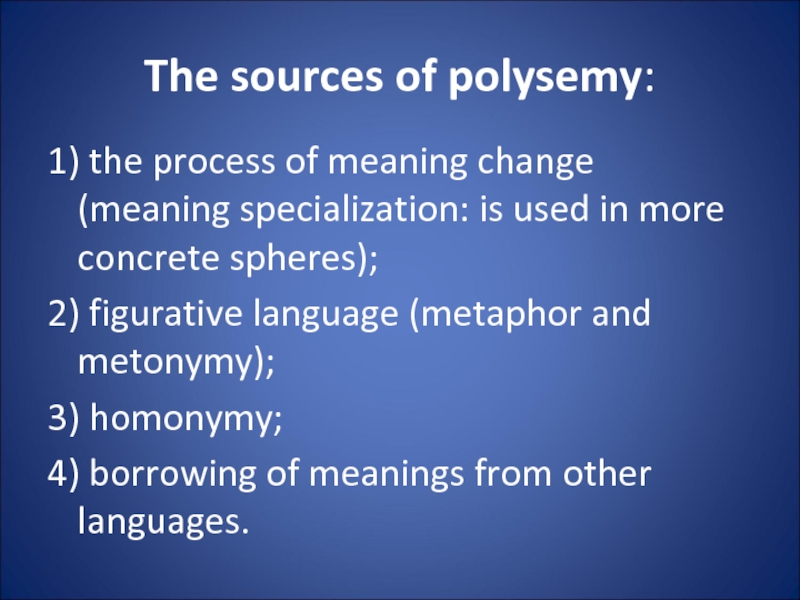
Слайд 46blanket
a woolen covering used on beds,
a covering for keeping a house
warm,
a covering of any kind (a blanket of snow),
covering in most cases (used attributively), e.g. we can say: a blanket insurance policy.
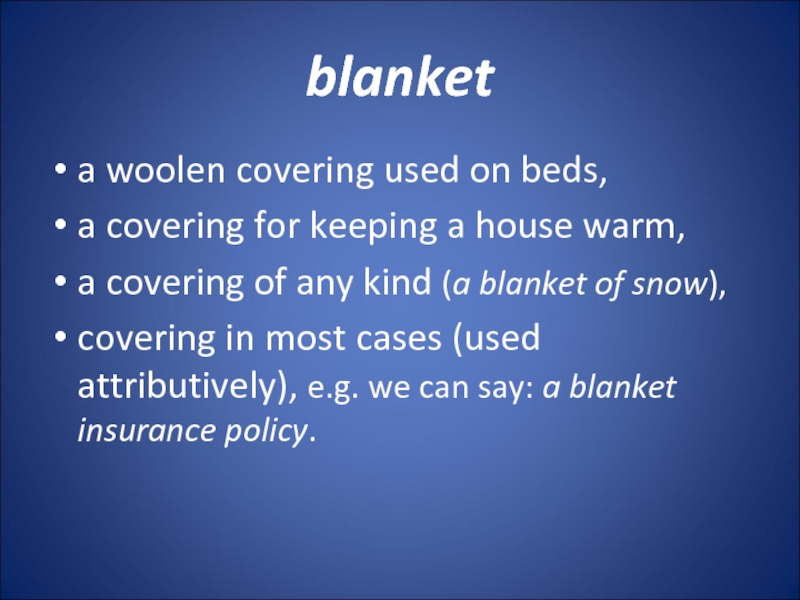
Слайд 47
Meanings of a polysemantic word are organized in a
semantic structure
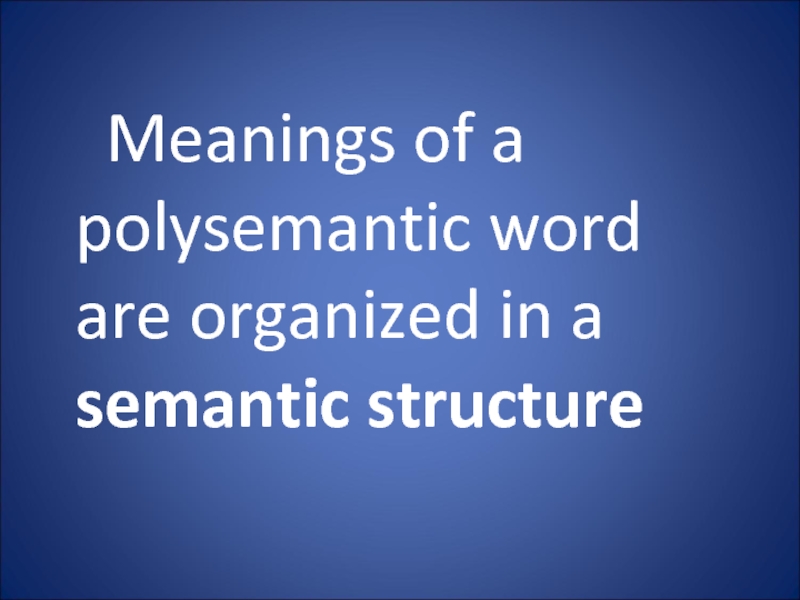
Слайд 48Lexical-semantic variant
one of the meanings of a polysemantic word used
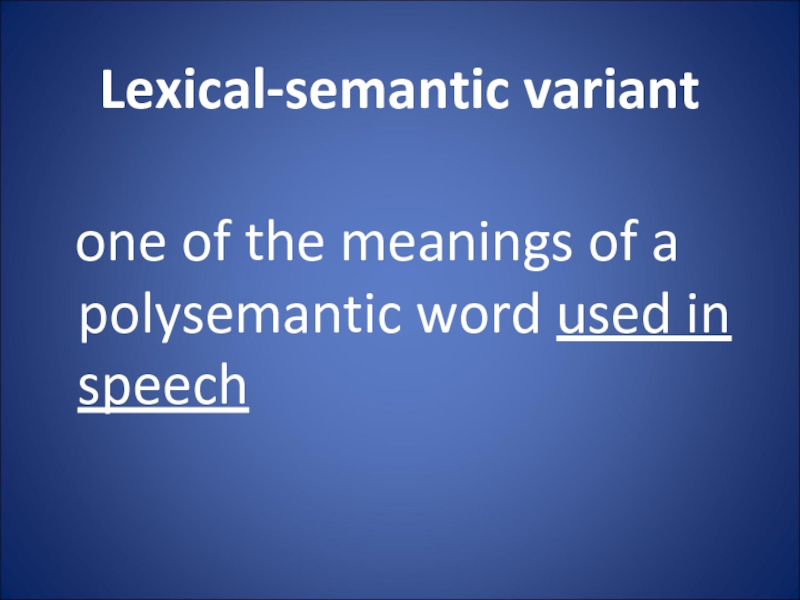
Слайд 49A Word’s Semantic Structure Is Studied:
Diachronically (in the process of its
historical development): the historical development and change of meaning becomes central. Focus: the process of acquiring new meanings.
Synchronically (at a certain period of time): a co-existence of different meanings in the semantic structure of the word at a certain period of language development. Focus: value of each individual meaning and frequency of its occurrence.

Слайд 50
The meaning first registered in the language is called primary.
Other
meanings are secondary, or derived, and are placed after the primary one.

Слайд 51table
a piece of furniture (primary meaning)
the persons
seated at the table
the food put on the table, meals
a thin flat piece of stone, metal, wood
slabs of stone
words cut into them or written on them
an orderly arrangement of facts
part of a machine-tool on which the work is put to be operated on
a level area, a plateau

Слайд 52
The meaning that first occurs to our mind, or is understood
without a special context is called the basic or main meaning.
Other meanings are called peripheral or minor.

Слайд 53Fire
1. flame (main meaning)
2. an instance of destructive burning
e.g. a forest fire
4. the shooting of guns
e.g. to open fire
3. burning material in a stone, fireplace
e.g. a camp fire
5. strong feeling, passion
e.g. speech lacking fire

Слайд 54Processes of the Semantic Development of a Word:
radiation (the primary meaning
stands in the center and the secondary meanings proceed out of it like rays. Each secondary meaning can be traced to the primary meaning)
concatenation (secondary meanings of a word develop like a chain. It is difficult to trace some meanings to the primary one)

Слайд 55crust
hard outer part of bread
hard part of anything (a
pie, a cake)
harder layer over soft snow
a sullen gloomy person
Impudence

Слайд 56
Polysemy exists not in speech but in the language.
It’s
easy to identify the main meaning of a separate word. Other meanings are revealed in context.

Слайд 57Context:
linguistic
1. lexical – a number of lexical units
around the word which enter into interaction with it (i.e. words combined with a polysemantic word are important).
2. grammatical – a number of lexical units around the world viewed on the level of parts of speech.
3. thematic – a very broad context, sometimes a text or even a book.
extralinguistic – different cultural, social, historical factors

Слайд 58
4. Change of word-meaning: the causes, nature and results

Слайд 59
The meaning of a word can change in a course
of time.

Слайд 60Causes of Change of
Word-meaning:
1. Extralinguistic (various changes in the life
of a speech community, in economic and social structure, in ideas, scientific concepts)
e.g. “car” meant ‘a four-wheeled wagon’; now – ‘a motor-car’, ‘a railway carriage’ (in the USA)
“paper” is not connected anymore with “papyrus” – the plant from which it formerly was made.
2. Linguistic (factors acting within the language system)

Слайд 61Linguistic Causes:
1. ellipsis – in a phrase made up of two
words one of these is omitted and its meaning is transferred to its partner.
e.g. “to starve” in O.E. = ‘to die’ + the word “hunger”. In the 16th c. “to starve” = ‘to die of hunger’.
e.g. daily = daily newspaper

Слайд 62Linguistic Causes:
2. differentiation (discrimination) of synonyms – when a new
word is borrowed it may become a perfect synonym for the existing one. They have to be differentiated; otherwise one of them will die.
e.g. “land” in O.E. = both ‘solid part of earth’s surface’ and ‘the territory of the nation’. In the middle E. period the word “country” was borrowed as its synonym; ‘the territory of a nation’ came to be denoted mainly by “country”.

Слайд 63Linguistic Causes:
3. linguistic analogy – if one of the members of
the synonymic set acquires a new meaning, other members of this set change their meaning too.
e.g. “to catch” acquired the meaning ‘to understand’; its synonyms “to grasp” and “to get” acquired this meaning too.

Слайд 64
The nature of semantic changes is based on the
secondary application of the word form to name a different yet related concept.
Conditions to any semantic change: some connection between the old meaning and the new.

Слайд 65Association between Old Meaning and New:
similarity of meanings or metaphor –
a semantic process of associating two referents one of which in some way resembles the other
contiguity (closeness) of meanings or metonymy – a semantic process of associating two referents one of which makes part of the other or is closely connected with it

Слайд 66Types of Metaphor:
a) similarity of shape, e.g. head (of a cabbage),
bottleneck, teeth (of a saw, a comb);
b) similarity of position, e.g. foot (of a page, of a mountain), head (of a procession);
c) similarity of function, behavior, e.g. a bookworm (a person who is fond of books);
d) similarity of color, e.g. orange, hazel, chestnut.

Слайд 67Types of Metonymy:
‘material — object of it’ (She is wearing a
fox);
‘container — containее’ (I ate three plates);
‘place — people’ (The city is asleep);
‘object — a unit of measure’ (This horse came one neck ahead);
‘producer — product’ (We bought a Picasso);
‘whole — part’ (We have 10 heads here);
‘count — mass’ (We ate rabbit)

Слайд 68Results of Semantic Change:
changes in the denotational component
changes in the connotational
meaning

Слайд 69Changes in the Denotational Component:
restriction – a word denotes a restricted
number of referents.
e.g. “fowl” in O.E. = ‘any bird’, but now ‘a domestic hen or chicken’
extension – the application of the word to a wider variety of referents
e.g. ‘‘a cook’’ was not applied to women until the 16th century.

Слайд 70
generalization – the word with the extended meaning passes from the
specialized vocabulary into common use and the meaning becomes more general.
e.g. “camp” = ‘the place where troops are lodged in tents’; now – ‘temporary quarters’.
specialization – the word with the new meaning comes to be used in the specialized vocabulary of some limited group.
e.g. “to glide” = ‘to move gently and smoothly’ and now has acquired a special meaning – ‘to fly with no engine’.

Слайд 71Changes in the Connotational Meaning:
pejorative development (degradation) – the acquisition by
the word of some derogatory emotive charge.
e.g. “accident” ‘a happening causing loss or injury’ came from more neutral ‘something that happened’;
ameliorative development (elevation) – the improvement of the connotational component of meaning.
e.g. “a minister” denoted a servant, now – ‘a civil servant of higher rank, a person administering a department of state’

Слайд 72List of Literature:
Антрушина, Г. Б. Лексикология английского языка: учебник для студ.
пед. ин-тов по спец. № 2103 «Иностр. яз.» / Г. Б. Антрушина, О. В. Афанасьева, Н. Н. Морозова; под ред. Г. Б. Антрушиной. – М.: Высш. школа, 1985. – С. 129–142, 147–160.
Воробей, А. Н. Глоссарий лингвистических терминов / А. Н. Воробей, Е. Г. Карапетова. – Барановичи: УО «БарГУ», 2004. – 108 с.
Дубенец, Э. М. Современный английский язык. Лексикология: пособие для студ. гуманит. вузов / Э. М. Дубенец. – М. / СПб.: ГЛОССА / КАРО, 2004. – С. 74–82, 123–127.
Лексикология английского языка: учебник для ин-тов и фак-тов иностр. яз. / Р. З. Гинзбург [и др.]; под общ. ред. Р. З. Гинзбург. – 2-е изд., испр. и доп. – М.: Высш. школа, 1979. – С. 13–23, 28–39, 47–51.
Лещева, Л. М. Слова в английском языке. Курс лексикологии современного английского языка: учебник для студ. фак-в и отдел. английского языка (на англ. яз.) / Л. М. Лещева. – Минск: Академия управления при Президенте Республики Беларусь, 2001. – С. 36–56.

Слайды и текст этой презентации
Слайд 1
Слайд 2
Описание слайда:
Plan:
Semantics / semasiology. Different approaches to word-meaning.
Types of word-meaning.
Polysemy. Semantic structure of words. Meaning and context.
Change of word-meaning: the causes, nature and results.
Слайд 3
Описание слайда:
List of Terms:
semantics
referent
referential meaning
grammatical meaning
lexical meaning
denotational meaning
connotational meaning
polysemantic word
polysemy
lexical-semantic variants
basic meaning
peripheral meaning
primary meaning
secondary meaning
Слайд 4
Описание слайда:
It is meaning that makes language useful.
George A. Miller,
The science of word, 1991
Слайд 5
Описание слайда:
1. Semantics / semasiology. Different approaches to word-meaning
Слайд 6
Описание слайда:
The function of the word as a unit of communication is possible by its possessing a meaning.
Among the word’s various characteristics meaning is the most important.
Слайд 7
Описание слайда:
«The Meaning of Meaning» (1923) by C.K. Ogden and I.A. Richards – about 20 definitions of meaning
Слайд 8
Слайд 9
Описание слайда:
This linguistic study was pointed out in 1897 by M. Breal
Слайд 10
Описание слайда:
Semasiology is a synonym for ‘semantics’
(from Gk. semasia ‘meaning’ + logos ‘learning’)
Слайд 11
Описание слайда:
Different Approaches to Word Meaning:
ideational (or conceptual)
referential
functional
Слайд 12
Описание слайда:
The ideational theory can be considered the earliest theory of meaning.
It states that meaning originates in the mind in the form of ideas, and words are just symbols of them.
Слайд 13
Описание слайда:
A difficulty:
not clear why communication and understanding are possible if linguistic expressions stand for individual personal ideas.
Слайд 14
Описание слайда:
Meaning:
a concept with specific structure.
Слайд 15
Описание слайда:
Do people speaking different languages have different conceptual systems?
If people speaking different languages have the same conceptual systems why are identical concepts expressed by correlative words having different lexical meanings?
Слайд 16
Описание слайда:
finger ‘one of 10 movable parts of joints at the end of each human hand, or one of 8 such parts as opposed to the thumbs‘
and
палец ‘подвижная конечная часть кисти руки, стопы ноги или лапы животного’
Слайд 17
Описание слайда:
Referential theory is based on interdependence of things, their concepts and names.
Слайд 18
Описание слайда:
The complex relationships between referent (object denoted by the word), concept and word are traditionally represented by the following triangle:
Thought = concept
Symbol = word Referent = object
Слайд 19
Описание слайда:
an animal, with 4
legs and a tail, can bark and bite
dog
Слайд 20
Описание слайда:
Meaning concept
different words having different meanings may be used to express the same concept
Слайд 21
Описание слайда:
Concept of dying
die
pass away
kick the bucket
join the majority, etc
Слайд 22
Описание слайда:
Meaning symbol
In different languages:
a word with the same meaning have different sound forms (dog, собака)
words with the same sound forms have different meaning (лук, look)
Слайд 23
Описание слайда:
Meaning referent
to denote one and the same object we can give it different names
Слайд 24
Описание слайда:
A horse
in various contexts:
horse,
animal,
creature,
it, etc.
Слайд 25
Описание слайда:
Word meaning:
the interrelation of all three components of the semantic triangle: symbol, concept and referent, though meaning is not equivalent to any of them.
Слайд 26
Описание слайда:
Functionalists study word meaning by analysis of the way the word is used in certain contexts.
Слайд 27
Описание слайда:
The meaning of a word is its use in language.
Слайд 28
Описание слайда:
cloud and cloudy
have different meanings because in speech they function differently and occupy different positions in relation to other words.
Слайд 29
Описание слайда:
Meaning:
a component of the word through which a concept is communicated
Слайд 30
Описание слайда:
2. Types of word-meaning
Слайд 31
Описание слайда:
According to the conception of word meaning as a specific structure:
functional meaning: part of speech meaning (nouns usually denote «thingness», adjectives – qualities and states)
grammatical: found in identical sets of individual forms of different words (she goes/works/reads, etc.)
lexical: the component of meaning proper to the word as a linguistic unit highly individual and recurs in all the forms of a word (the meaning of the verb to work ‘to engage in physical or mental activity’ that is expressed in all its forms: works, work, worked, working, will work)
Слайд 32
Описание слайда:
Lexical Meaning:
denotational
connotational
Слайд 33
Описание слайда:
Denotational lexical meaning provides correct reference of a word to an individual object or a concept.
It makes communication possible and is explicitly revealed in the dictionary definition (chair ‘a seat for one person typically having four legs and a back’).
Слайд 34
Описание слайда:
to glare – to look
Слайд 35
Описание слайда:
Connotational lexical meaning is an emotional colouring of the word. Unlike denotational meaning, connotations are optional.
Слайд 36
Описание слайда:
Connotations:
Emotive charge may be inherent in word meaning (like in attractive, repulsive) or may be created by prefixes and suffixes (like in piggy, useful, useless).
It’s always objective because it doesn’t depend on a person’s perception.
Слайд 37
Описание слайда:
2. Stylistic reference refers the word to a certain style:
neutral words
colloquial
bookish, or literary words
Eg. father – dad – parent .
Слайд 38
Описание слайда:
3. Evaluative connotations express approval or disapproval (charming, disgusting).
4. Intensifying connotations are expressive and emphatic (magnificent, gorgeous)
Слайд 39
Описание слайда:
Denotative component
Lonely = alone, without company
To glare = to look
Слайд 40
Описание слайда:
3. Polysemy. Semantic structure of words. Meaning and context
Слайд 41
Описание слайда:
A polysemantic word is a word having more than one meaning.
Polysemy is the ability of words to have more than one meaning.
Слайд 42
Описание слайда:
Most English words are polysemantic.
A well-developed polysemy is a great advantage in a language.
Слайд 43
Описание слайда:
Monosemantic Words:
terms (synonym, bronchitis, molecule),
pronouns (this, my, both),
numerals, etc.
Слайд 44
Описание слайда:
The main causes of polysemy:
a large number of:
1) monosyllabic words;
2) words of long duration (that existed for centuries).
Слайд 45
Описание слайда:
The sources of polysemy:
1) the process of meaning change (meaning specialization: is used in more concrete spheres);
2) figurative language (metaphor and metonymy);
3) homonymy;
4) borrowing of meanings from other languages.
Слайд 46
Описание слайда:
blanket
a woolen covering used on beds,
a covering for keeping a house warm,
a covering of any kind (a blanket of snow),
covering in most cases (used attributively), e.g. we can say: a blanket insurance policy.
Слайд 47
Описание слайда:
Meanings of a polysemantic word are organized in a semantic structure
Слайд 48
Описание слайда:
Lexical-semantic variant
one of the meanings of a polysemantic word used in speech
Слайд 49
Описание слайда:
A Word’s Semantic Structure Is Studied:
Diachronically (in the process of its historical development): the historical development and change of meaning becomes central. Focus: the process of acquiring new meanings.
Synchronically (at a certain period of time): a co-existence of different meanings in the semantic structure of the word at a certain period of language development. Focus: value of each individual meaning and frequency of its occurrence.
Слайд 50
Описание слайда:
The meaning first registered in the language is called primary.
Other meanings are secondary, or derived, and are placed after the primary one.
Слайд 51
Описание слайда:
table
a piece of furniture (primary meaning)
the persons seated at the table
the food put on the table, meals
a thin flat piece of stone, metal, wood
slabs of stone
words cut into them or written on them
an orderly arrangement of facts
part of a machine-tool on which the work is put to be operated on
a level area, a plateau
Слайд 52
Описание слайда:
The meaning that first occurs to our mind, or is understood without a special context is called the basic or main meaning.
Other meanings are called peripheral or minor.
Слайд 53
Описание слайда:
Fire
1. flame (main meaning)
Слайд 54
Описание слайда:
Processes of the Semantic Development of a Word:
radiation (the primary meaning stands in the center and the secondary meanings proceed out of it like rays. Each secondary meaning can be traced to the primary meaning)
concatenation (secondary meanings of a word develop like a chain. It is difficult to trace some meanings to the primary one)
Слайд 55
Описание слайда:
crust
hard outer part of bread
hard part of anything (a pie, a cake)
harder layer over soft snow
a sullen gloomy person
Impudence
Слайд 56
Описание слайда:
Polysemy exists not in speech but in the language.
It’s easy to identify the main meaning of a separate word. Other meanings are revealed in context.
Слайд 57
Описание слайда:
Context:
linguistic
1. lexical – a number of lexical units around the word which enter into interaction with it (i.e. words combined with a polysemantic word are important).
2. grammatical – a number of lexical units around the world viewed on the level of parts of speech.
3. thematic – a very broad context, sometimes a text or even a book.
extralinguistic – different cultural, social, historical factors
Слайд 58
Описание слайда:
4. Change of word-meaning: the causes, nature and results
Слайд 59
Описание слайда:
The meaning of a word can change in a course of time.
Слайд 60
Описание слайда:
Causes of Change of
Word-meaning:
1. Extralinguistic (various changes in the life of a speech community, in economic and social structure, in ideas, scientific concepts)
e.g. “car” meant ‘a four-wheeled wagon’; now – ‘a motor-car’, ‘a railway carriage’ (in the USA)
“paper” is not connected anymore with “papyrus” – the plant from which it formerly was made.
2. Linguistic (factors acting within the language system)
Слайд 61
Описание слайда:
Linguistic Causes:
1. ellipsis – in a phrase made up of two words one of these is omitted and its meaning is transferred to its partner.
e.g. “to starve” in O.E. = ‘to die’ + the word “hunger”. In the 16th c. “to starve” = ‘to die of hunger’.
e.g. daily = daily newspaper
Слайд 62
Описание слайда:
Linguistic Causes:
2. differentiation (discrimination) of synonyms – when a new word is borrowed it may become a perfect synonym for the existing one. They have to be differentiated; otherwise one of them will die.
e.g. “land” in O.E. = both ‘solid part of earth’s surface’ and ‘the territory of the nation’. In the middle E. period the word “country” was borrowed as its synonym; ‘the territory of a nation’ came to be denoted mainly by “country”.
Слайд 63
Описание слайда:
Linguistic Causes:
3. linguistic analogy – if one of the members of the synonymic set acquires a new meaning, other members of this set change their meaning too.
e.g. “to catch” acquired the meaning ‘to understand’; its synonyms “to grasp” and “to get” acquired this meaning too.
Слайд 64
Описание слайда:
The nature of semantic changes is based on the secondary application of the word form to name a different yet related concept.
Conditions to any semantic change: some connection between the old meaning and the new.
Слайд 65
Описание слайда:
Association between Old Meaning and New:
similarity of meanings or metaphor – a semantic process of associating two referents one of which in some way resembles the other
contiguity (closeness) of meanings or metonymy – a semantic process of associating two referents one of which makes part of the other or is closely connected with it
Слайд 66
Описание слайда:
Types of Metaphor:
a) similarity of shape, e.g. head (of a cabbage), bottleneck, teeth (of a saw, a comb);
b) similarity of position, e.g. foot (of a page, of a mountain), head (of a procession);
c) similarity of function, behavior, e.g. a bookworm (a person who is fond of books);
d) similarity of color, e.g. orange, hazel, chestnut.
Слайд 67
Описание слайда:
Types of Metonymy:
‘material — object of it’ (She is wearing a fox);
‘container — containее’ (I ate three plates);
‘place — people’ (The city is asleep);
‘object — a unit of measure’ (This horse came one neck ahead);
‘producer — product’ (We bought a Picasso);
‘whole — part’ (We have 10 heads here);
‘count — mass’ (We ate rabbit)
Слайд 68
Описание слайда:
Results of Semantic Change:
changes in the denotational component
changes in the connotational meaning
Слайд 69
Описание слайда:
Changes in the Denotational Component:
restriction – a word denotes a restricted number of referents.
e.g. “fowl” in O.E. = ‘any bird’, but now ‘a domestic hen or chicken’
extension – the application of the word to a wider variety of referents
e.g. ‘‘a cook’’ was not applied to women until the 16th century.
Слайд 70
Описание слайда:
generalization – the word with the extended meaning passes from the specialized vocabulary into common use and the meaning becomes more general.
e.g. “camp” = ‘the place where troops are lodged in tents’; now – ‘temporary quarters’.
specialization – the word with the new meaning comes to be used in the specialized vocabulary of some limited group.
e.g. “to glide” = ‘to move gently and smoothly’ and now has acquired a special meaning – ‘to fly with no engine’.
Слайд 71
Описание слайда:
Changes in the Connotational Meaning:
pejorative development (degradation) – the acquisition by the word of some derogatory emotive charge.
e.g. “accident” ‘a happening causing loss or injury’ came from more neutral ‘something that happened’;
ameliorative development (elevation) – the improvement of the connotational component of meaning.
e.g. “a minister” denoted a servant, now – ‘a civil servant of higher rank, a person administering a department of state’
Слайд 72
Описание слайда:
List of Literature:
Антрушина, Г. Б. Лексикология английского языка: учебник для студ. пед. ин-тов по спец. № 2103 «Иностр. яз.» / Г. Б. Антрушина, О. В. Афанасьева, Н. Н. Морозова; под ред. Г. Б. Антрушиной. – М.: Высш. школа, 1985. – С. 129–142, 147–160.
Воробей, А. Н. Глоссарий лингвистических терминов / А. Н. Воробей, Е. Г. Карапетова. – Барановичи: УО «БарГУ», 2004. – 108 с.
Дубенец, Э. М. Современный английский язык. Лексикология: пособие для студ. гуманит. вузов / Э. М. Дубенец. – М. / СПб.: ГЛОССА / КАРО, 2004. – С. 74–82, 123–127.
Лексикология английского языка: учебник для ин-тов и фак-тов иностр. яз. / Р. З. Гинзбург [и др.]; под общ. ред. Р. З. Гинзбург. – 2-е изд., испр. и доп. – М.: Высш. школа, 1979. – С. 13–23, 28–39, 47–51.
Лещева, Л. М. Слова в английском языке. Курс лексикологии современного английского языка: учебник для студ. фак-в и отдел. английского языка (на англ. яз.) / Л. М. Лещева. – Минск: Академия управления при Президенте Республики Беларусь, 2001. – С. 36–56.
1. Lecture 3 Semantic Structure of the Word and Its Changes
Lecture 3
2. Plan:
1. Semantics / semasiology. Different
approaches to word-meaning.
2. Types of word-meaning.
3. Polysemy. Semantic structure of
words. Meaning and context.
4. Change of word-meaning: the
causes, nature and results.
3. List of Terms:
semantics
referent
referential meaning
grammatical meaning
lexical meaning
denotational meaning
connotational meaning
polysemantic word
polysemy
lexical-semantic variants
basic meaning
peripheral meaning
primary meaning
secondary meaning
radiation
concatenation
lexical context
grammatical context
thematic context
ellipsis
differentiation of synonyms
linguistic analogy
metaphor
metonymy
restriction of meaning
extension of meaning
ameliorative development of meaning
pejorative development of meaning
4.
It is meaning that makes
language useful.
George A. Miller,
The science of word, 1991
5.
1. Semantics / semasiology.
Different approaches to wordmeaning
6.
The function of the word as a
unit of communication is possible
by its possessing a meaning.
Among the word’s various
characteristics meaning is the
most important.
7.
• «The Meaning of
Meaning» (1923) by C.K.
Ogden and I.A. Richards
– about 20 definitions of
meaning
8.
Meaning of a linguistic
unit, or linguistic
meaning, is studied by
semantics
(from Greek – semanticos
‘significant’)
9.
This linguistic study was
pointed out in 1897 by
M. Breal
10.
Semasiology is a synonym
for ‘semantics’
(from Gk. semasia ‘meaning’ +
logos ‘learning’)
11. Different Approaches to Word Meaning:
• ideational (or conceptual)
• referential
• functional
12.
The ideational theory can be
considered the earliest theory
of meaning.
It states that meaning
originates in the mind in the
form of ideas, and words are
just symbols of them.
13. A difficulty:
• not clear why communication
and understanding are possible if
linguistic expressions stand for
individual personal ideas.
14. Meaning:
• a concept with specific
structure.
15.
• Do people speaking different
languages have different conceptual
systems?
• If
people
speaking
different
languages have the same conceptual
systems why are identical concepts
expressed by correlative words
having different lexical meanings?
16.
• finger ‘one of 10 movable parts of
joints at the end of each human
hand, or one of 8 such parts as
opposed to the thumbs‘
and
• палец ‘подвижная конечная часть
кисти руки, стопы ноги или лапы
животного’
17.
Referential theory is
based on interdependence
of things, their concepts
and names.
18.
The complex relationships between
referent (object denoted by the word),
concept and word are traditionally
represented by the following triangle:
Thought = concept
Symbol = word
Referent = object
19. an animal, with 4 legs and a tail, can bark and bite dog
20. Meaning concept
• different words having different
meanings may be used to express
the same concept
21. Concept of dying
die
pass away
kick the bucket
join the majority, etc
22. Meaning symbol
In different languages:
• a word with the same meaning have
different sound forms (dog, собака)
• words with the same sound forms
have different meaning (лук, look)
23. Meaning referent
• to denote one and the same
object we can give it different
names
24. A horse
in various contexts:
• horse,
• animal,
• creature,
• it, etc.
25. Word meaning:
the interrelation of all three
components of the semantic
triangle: symbol, concept and
referent, though meaning is not
equivalent to any of them.
26.
Functionalists study word
meaning by analysis of the way
the word is used in certain
contexts.
27.
The meaning of a word
is its use in language.
28. cloud and cloudy
• have different meanings because
in speech they function
differently and occupy different
positions in relation to other
words.
29. Meaning:
a component of the word
through which a concept is
communicated
30.
2. Types of word-meaning
31. According to the conception of word meaning as a specific structure:
• functional meaning: part of speech meaning
(nouns usually denote «thingness», adjectives – qualities and
states)
• grammatical: found in identical sets of
individual forms of different words (she
goes/works/reads, etc.)
• lexical: the component of meaning proper to
the word as a linguistic unit
highly
individual and recurs in all the forms of a word
(the meaning of the verb to work ‘to engage in physical or
mental activity’ that is expressed in all its forms: works, work,
worked, working, will work)
32. Lexical Meaning:
• denotational
• connotational
33.
• Denotational lexical meaning
provides correct reference of a word
to an individual object or a concept.
• It makes communication possible
and is explicitly revealed in the
dictionary definition (chair ‘a seat for
one person typically having four legs and
a back’).
34.
•to glare – to look
35.
Connotational lexical
meaning is an emotional
colouring of the word.
Unlike denotational
meaning, connotations are
optional.
36. Connotations:
1. Emotive charge may be inherent in
word meaning (like in attractive,
repulsive) or may be created by
prefixes and suffixes (like in piggy,
useful, useless).
It’s always objective because it doesn’t
depend on a person’s perception.
37.
2. Stylistic reference refers the word
to a certain style:
• neutral words
• colloquial
• bookish, or literary words
Eg. father – dad – parent .
38.
3. Evaluative connotations express
approval or disapproval (charming,
disgusting).
4. Intensifying connotations are
expressive and emphatic (magnificent,
gorgeous)
39.
Denotative
component
Connotative
component
• Lonely = alone, without
company
+ melancholy, sad
(emotive con.)
• To glare = to look
+ 1) steadily, lastingly
(con. of duration)
+ 2) in anger, rage
(emotive con.)
40.
3. Polysemy. Semantic
structure of words.
Meaning and context
41.
• A polysemantic word is a word
having more than one meaning.
• Polysemy is the ability of words
to have more than one meaning.
42.
Most English words are
polysemantic.
A well-developed
polysemy is a great
advantage in a language.
43. Monosemantic Words:
• terms (synonym, bronchitis,
molecule),
• pronouns (this, my, both),
• numerals, etc.
44. The main causes of polysemy:
a large number of:
1) monosyllabic words;
2) words of long duration (that
existed for centuries).
45. The sources of polysemy:
1) the process of meaning change
(meaning specialization: is used in more
concrete spheres);
2) figurative language (metaphor and
metonymy);
3) homonymy;
4) borrowing of meanings from other
languages.
46. blanket
a woolen covering used on beds,
a covering for keeping a house warm,
a covering of any kind (a blanket of snow),
covering in most cases (used
attributively), e.g. we can say: a blanket
insurance policy.
47.
Meanings of a
polysemantic word
are organized in a
semantic structure
48. Lexical-semantic variant
one of the meanings of a
polysemantic word used in
speech
49. A Word’s Semantic Structure Is Studied:
Diachronically (in the process of its historical
development): the historical development and change
of meaning becomes central. Focus: the process of
acquiring new meanings.
Synchronically (at a certain period of time): a coexistence of different meanings in the semantic
structure of the word at a certain period of language
development. Focus: value of each individual meaning
and frequency of its occurrence.
50.
• The meaning first registered in
the language is called primary.
• Other meanings are secondary, or
derived, and are placed after the
primary one.
51. table
1.
2.
3.
4.
5.
6.
7.
8.
a piece of furniture
(primary meaning)
the persons seated at the table
the food put on the table, meals
a thin flat piece of stone, metal, wood
slabs of stone
words cut into them or written on them
an orderly arrangement of facts
part of a machine-tool on which the work is put to
be operated on
9. a level area, a plateau
52.
• The meaning that first occurs to
our mind, or is understood
without a special context is called
the basic or main meaning.
• Other meanings are called
peripheral or minor.
53. Fire
1. flame (main meaning)
2. an instance of destructive
burning
e.g. a forest fire
3. burning material in a stone,
fireplace
e.g. a camp fire
4. the shooting of guns
e.g. to open fire
5. strong feeling, passion
e.g. speech lacking fire
54. Processes of the Semantic Development of a Word:
• radiation (the primary meaning stands in
the center and the secondary meanings
proceed out of it like rays. Each secondary
meaning can be traced to the primary
meaning)
• concatenation (secondary meanings of a
word develop like a chain. It is difficult to trace
some meanings to the primary one)
55. crust
hard outer part of bread
hard part of anything (a pie, a cake)
harder layer over soft snow
a sullen gloomy person
Impudence
56.
Polysemy exists not in speech but
in the language.
It’s easy to identify the main
meaning of a separate word. Other
meanings are revealed in context.
57. Context:
• linguistic
1. lexical – a number of lexical units around the word
which enter into interaction with it (i.e. words
combined with a polysemantic word are important).
2. grammatical – a number of lexical units around
the world viewed on the level of parts of speech.
3. thematic – a very broad context, sometimes a text
or even a book.
• extralinguistic – different cultural, social,
historical factors
58.
4. Change of wordmeaning: the causes,
nature and results
59.
The meaning of a word
can change in a course of
time.
60. Causes of Change of Word-meaning:
1. Extralinguistic (various changes in the life of a
speech community, in economic and social
structure, in ideas, scientific concepts)
• e.g. “car” meant ‘a four-wheeled wagon’; now – ‘a
motor-car’, ‘a railway carriage’ (in the USA)
• “paper” is not connected anymore with “papyrus” –
the plant from which it formerly was made.
2. Linguistic (factors acting within the
language system)
61. Linguistic Causes:
1. ellipsis – in a phrase made up of two words
one of these is omitted and its meaning is
transferred to its partner.
e.g. “to starve” in O.E. = ‘to die’ + the word “hunger”.
In the 16th c. “to starve” = ‘to die of hunger’.
e.g. daily = daily newspaper
62. Linguistic Causes:
differentiation (discrimination) of
synonyms – when a new word is borrowed it
2.
may become a perfect synonym for the existing
one. They have to be differentiated; otherwise
one of them will die.
e.g. “land” in O.E. = both ‘solid part of earth’s surface’ and
‘the territory of the nation’. In the middle E. period the word
“country” was borrowed as its synonym; ‘the territory of a
nation’ came to be denoted mainly by “country”.
63. Linguistic Causes:
3. linguistic analogy – if one of the
members of the synonymic set acquires a
new meaning, other members of this set
change their meaning too.
e.g. “to catch” acquired the meaning ‘to
understand’; its synonyms “to grasp” and “to get”
acquired this meaning too.
64.
The nature of semantic changes is
based on the secondary application of
the word form to name a different yet
related concept.
Conditions to any semantic change:
some connection between the old
meaning and the new.
65. Association between Old Meaning and New:
• similarity of meanings or metaphor – a
semantic process of associating two referents
one of which in some way resembles the
other
• contiguity (closeness) of meanings or
metonymy – a semantic process of associating
two referents one of which makes part of the
other or is closely connected with it
66. Types of Metaphor:
a) similarity of shape, e.g. head (of a
cabbage), bottleneck, teeth (of a saw, a comb);
b) similarity of position, e.g. foot (of a page,
of a mountain), head (of a procession);
c) similarity of function, behavior, e.g. a
bookworm (a person who is fond of books);
d) similarity of color, e.g. orange, hazel,
chestnut.
67. Types of Metonymy:
‘material — object of it’ (She is wearing a fox);
‘container — containее’ (I ate three plates);
‘place — people’ (The city is asleep);
‘object — a unit of measure’ (This horse came
one neck ahead);
• ‘producer — product’ (We bought a Picasso);
• ‘whole — part’ (We have 10 heads here);
• ‘count — mass’ (We ate rabbit)
68. Results of Semantic Change:
• changes in the denotational
component
• changes in the connotational
meaning
69. Changes in the Denotational Component:
• restriction
– a word denotes a restricted
number of referents.
e.g. “fowl” in O.E. = ‘any bird’, but now ‘a domestic hen
or chicken’
• extension
– the application of the word to a
wider variety of referents
e.g. ‘‘a cook’’ was not applied to women until the 16th
century.
70.
• generalization – the word with the extended
meaning passes from the specialized
vocabulary into common use and the meaning
becomes more general.
e.g. “camp” = ‘the place where troops are
lodged in tents’; now – ‘temporary quarters’.
• specialization – the word with the new
meaning comes to be used in the specialized
vocabulary of some limited group.
e.g. “to glide” = ‘to move gently and
smoothly’ and now has acquired a special
meaning – ‘to fly with no engine’.
71. Changes in the Connotational Meaning:
• pejorative development (degradation) – the
acquisition by the word of some derogatory emotive
charge.
e.g. “accident” ‘a happening causing loss or injury’
came from more neutral ‘something that happened’;
• ameliorative development (elevation) – the
improvement of the connotational component of
meaning.
e.g. “a minister” denoted a servant, now – ‘a civil
servant of higher rank, a person administering a
department of state’
72. List of Literature:
1.
2.
3.
4.
5.
Антрушина, Г. Б. Лексикология английского языка: учебник для студ.
пед. ин-тов по спец. № 2103 «Иностр. яз.» / Г. Б. Антрушина, О. В.
Афанасьева, Н. Н. Морозова; под ред. Г. Б. Антрушиной. – М.: Высш.
школа, 1985. – С. 129–142, 147–160.
Воробей, А. Н. Глоссарий лингвистических терминов / А. Н. Воробей,
Е. Г. Карапетова. – Барановичи: УО «БарГУ», 2004. – 108 с.
Дубенец, Э. М. Современный английский язык. Лексикология:
пособие для студ. гуманит. вузов / Э. М. Дубенец. – М. / СПб.:
ГЛОССА / КАРО, 2004. – С. 74–82, 123–127.
Лексикология английского языка: учебник для ин-тов и фак-тов
иностр. яз. / Р. З. Гинзбург [и др.]; под общ. ред. Р. З. Гинзбург. – 2-е
изд., испр. и доп. – М.: Высш. школа, 1979. – С. 13–23, 28–39, 47–51.
Лещева, Л. М. Слова в английском языке. Курс лексикологии
современного английского языка: учебник для студ. фак-в и отдел.
английского языка (на англ. яз.) / Л. М. Лещева. – Минск: Академия
управления при Президенте Республики Беларусь, 2001. – С. 36–56.








































































![List of Literature:
Антрушина, Г. Б. Лексикология английского языка: учебник для студ. пед. ин-тов по спец. № 2103 "Иностр. яз." / Г. Б. Антрушина, О. В. Афанасьева, Н. Н. Морозова; под ред. Г. Б. Антрушиной. – М.: Высш. школа, 1985. – С. 129–142, 147–160.
Воробей, А. Н. Глоссарий лингвистических терминов / А. Н. Воробей, Е. Г. Карапетова. – Барановичи: УО "БарГУ", 2004. – 108 с.
Дубенец, Э. М. Современный английский язык. Лексикология: пособие для студ. гуманит. вузов / Э. М. Дубенец. – М. / СПб.: ГЛОССА / КАРО, 2004. – С. 74–82, 123–127.
Лексикология английского языка: учебник для ин-тов и фак-тов иностр. яз. / Р. З. Гинзбург [и др.]; под общ. ред. Р. З. Гинзбург. – 2-е изд., испр. и доп. – М.: Высш. школа, 1979. – С. 13–23, 28–39, 47–51.
Лещева, Л. М. Слова в английском языке. Курс лексикологии современного английского языка: учебник для студ. фак-в и отдел. английского языка (на англ. яз.) / Л. М. Лещева. – Минск: Академия управления при Президенте Республики Беларусь, 2001. – С. 36–56.](https://myslide.ru/documents_3/42a164a5a4e7b28700c7e7daf5bc5db6/img71.jpg)